






The health and well-being of your employees matters. UnitedHealthcare is here to help you guide them toward brighter days ahead. From finding new ways of controlling costs to connecting them with medical care and mental health support, it’s good to have a health plan that’s on their side and in your corner.
Learn more at uhc.com

40 U.S. Egg: A Family-Owned Restaurant Making a Social Impact
This month spotlighting U.S. Egg, Tyler Butler’s series explores the myriad ways businesses give back and the positive ways their programs impact our community.
42
The Importance of Preparing the Next Generation for Leadership Roles Bruce Weber’s series examines developing and sustaining organizational capacity.
43 Office Conversion: Vacancy to Vibrancy
In this recurring feature from global design and architecture firm Gensler, Jay Silverberg discusses the conversion potential of vacant office space to diverse options, from residential to hospitality to community spaces.
34 Jump-Starting and Scaling a Marketplace
Shirish Nadkarni offers case studies in strategy.
9 Guest Editor Brad Schoenberg, Phoenix Division President at Taylor Morrison, Inc., introduces the “Housing” issue.

10 Feedback
Scott Cooper, Dan Henderson and Joe Pizzillo respond to In Business Magazine’s burning business question of the month: How is the availability or development of various housing product impacting economic development in your city?
11 Briefs
“This Lawyer’s New Bestie Is ChatGPT,” “Dailies Top Stories,” “Local Standouts Recognized for Achievements and Philanthropy,” “The True Cost of Losing an RFP” and “Interest in Employee Tracking Trending Up”
14 Startups
“Biotech Consulting of AZ Helps Innovative Companies Market to Investors” and “Quasar Quantum Healing Promotes a Full-Body Approach”
47 Tempe Chamber of Commerce
15 CRE
“Membership Model for Senior-Living Developments” and “Infill Housing and Sustainable Construction: A Solution to Phoenix’s Water Woes”
16 From the Top
Christo Demetriades manifests the power of entrepreneurial perseverance, bringing his can-do spirit with him from South Africa to Scottsdale.
18 Semi Insights
53 2023 Top Residential Real Estate Leaders
“ASU, Advantest and NXP Join Forces,” “Bechtel Expands Its Reach” and “Foresight Technologies Launches Cutting-Edge Center of Excellence”

26 Home Economics: Does the Housing Market Impact Our Economic Growth?
The relationship between housing and the economy generates a cause-and-effect discussion. With input from builders, city planners and economists, In Business Magazine explores the issue in this month’s cover story.
22 Healthcare
“Prioritizing Health + Wealth with a Health Payment Account” and “Serving an Underserved Demographic”
24 Technology
“How To: Use Social Media to Grow Business” and “Work from Home? How to Get the Most Out of Home Internet”
35 Books
New releases give fresh insights on business thinking.
36 En Negocios
Feature articles in Spanish and English on Finanzas / Finance.
38 Economy
Chargeback triangle – by Monica Eaton. Description to come.
39 Legal
Attorney Melissa L. Shingles discusses why companies should consider developing guidelines regarding AI technologies.
44 Nonprofit
Richard Tollefson explores the current challenges in philanthropy from inflation even with 2022 GDP growth and historically low unemployment.
45 Assets
2024 EV Hummer SUV and Truck Plus: Direct Marketing Automation Enhances Human Connection

46 Power Lunch
Z’Tejas – Elevated Tex-Mex in a Sophisticated Ambience
66 Roundtable
An open letter on “Empowered Success” from the all-female Courtesy Automotive Group finance director “Dream Team.”
According to a report published by the National Apartment Association (NAA) and National Multifamily Housing Council (NMHC) in 2019 titled, “The Contribution of Multifamily Housing to the U.S. Economy,” in 2016, the apartment industry generated $3.4 trillion of national economic output and supported 17.5 million U.S. jobs. This represented almost 19% of total U.S. Gross Domestic Product (GDP) (in nominal dollars) and 12% of the employment growth for that year.


In Business Magazine is a collaboration of many business organizations and entities throughout the metropolitan Phoenix area and Arizona. Our mission is to inform and energize business in this community by communicating content that will build business and enrich the economic picture for all of us vested in commerce.
Kristen Merrifield, CEO Alliance of Arizona Nonprofits (602) 279-2966 www.arizonanonprofits.org

Debbie Hann, Chief Operating Officer Arizona Small Business Association Central Office (602) 306-4000 www.asba.com
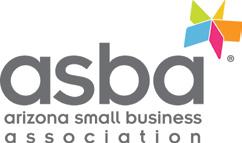
Steven G. Zylstra, President & CEO Arizona Technology Council One Renaissance Square (602) 343-8324 www.aztechcouncil.org
Doug Bruhnke, Founder & President Global Chamber® (480) 595-5000 www.globalchamber.org
Suzi Freeman, President NAWBO Phoenix Metro Chapter (480) 289-5768 www.nawbophx.org
Colin Diaz, President & CEO Tempe Chamber of Commerce (480) 967-7891 www.tempechamber.org
Our Partner Organizations are vested business organizations focused on building and improving business in the Valley or throughout Arizona. As Partners, each will receive three insert publications each year to showcase all that they are doing for business and businesspeople within our community. We encourage you to join these and other organizations to better your business opportunities. The members of these and other Associate Partner Organizations receive a subscription to In Business Magazine each month. For more information on becoming an Associate Partner, please contact our publisher at info@inbusinessphx.com
Ahwatukee Foothills Chamber of Commerce ahwatukeechamber.com
Arizona Chamber of Commerce & Industry azchamber.com
Arizona Hispanic Chamber of Commerce azhcc.com
The Black Chamber of Arizona phoenixblackchamber.com
Chandler Chamber of Commerce chandlerchamber.com Economic Club of Phoenix econclubphx.org
Glendale Chamber of Commerce glendaleazchamber.org
Greater Phoenix Chamber of Commerce phoenixchamber.com
Greater Phoenix Equality Chamber of Commerce gpglcc.org
Mesa Chamber of Commerce mesachamber.org
North Phoenix Chamber of Commerce northphoenixchamber.com
Peoria Chamber of Commerce peoriachamber.com

Phoenix Metro Chamber of Commerce phoenixmetrochamber.com
Scottsdale Area Chamber of Commerce scottsdalechamber.com
Scottsdale Coalition of Today and Tomorrow (SCOTT) scottnow.com
Surprise Regional Chamber of Commerce surpriseregionalchamber.com
WESTMARC westmarc.org

Making energy-efficient upgrades with SRP Business Solutions pays off. We offer a range of rebates on things like new HVAC systems and refrigeration to LED lighting and EV fleet transformations. If it saves energy, chances are SRP has a rebate for it.
See a list of available rebates at savewithsrpbiz.com
RaeAnne Marsh became editorial director of Phoenix-based InMedia Company in 2010 and helped launch Valley-wide business resource In Business Magazine. Her journalism career began more than 20 years ago, when she left California and 12 years of teaching to transplant in Phoenix’s vibrant entrepreneurial environment, and includes incorporating her own business, Grammar & Glitz, Inc., through which she has taken writing and editing gigs with business and media clients nationwide. Holding the magazine to strong editorial standards, she says, “New businesses are founded, out-of-staters bring new strengths, established businesses evolve and expand — all of which contributes to the dynamic vitality that I see as the mission of In Business Magazine to be the voice of and vehicle to nurture, in each monthly edition. It is my challenge to ensure each edition is packed with relevant information on a broad spectrum of issues, aimed at a readership that runs the gamut from entrepreneurial startup to major corporation.”
As editor of the Spanish section of In Business Magazine, Edgar R. Olivo shares weekly content for Spanish-preferred small-business owners in Phoenix. As a first-generation Latinx and native-Arizonan, Olivo’s upbringing was filled with similar challenges that Latino communities in Arizona face when they engage with the economy. An entrepreneur and nonprofit executive, he is leading the charge to help strengthen a diverse, inclusive and sustainable entrepreneurial ecosystem in Arizona. His work is nationally recognized for establishing programs that help advance equitable economic recovery, and increase generational wealth for Latinx/Hispanic small business owners in Arizona.
“I believe today is a moment for leading big change. Business ownership is a critical means to build community and individual wealth. I hope my work will demonstrate to the Latino community that the entrepreneur ecosystem in Arizona has their back.”
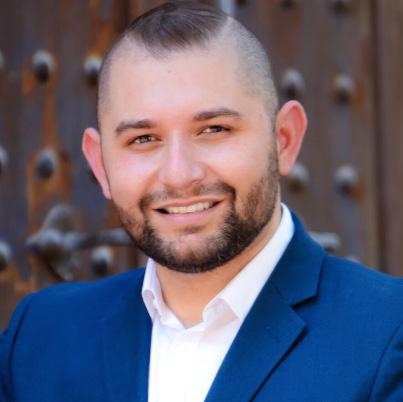
Guest columns are feature articles presented as a special, limited series as well as regular, ongoing series in In Business Magazine.
Guest Columnist – Social Impact
A long time corporate social responsibility practitioner, Tyler Butler is known for her expertise in creating, launching and developing successful social impact programs. Her commitment to rallying people together to make a positive difference has created sustainable signature programs empowering people to give back in a myriad of ways globally. Butler operates under the ethos of “each one teach one,” and so her contributions to In Business Magazine provide her with an outlet to share the best of what companies are doing to aid humanity. Butler looks to shed light on good corporate citizens and share stories about the magic they are creating through their generous outreach efforts.
Guest Columnist – Metro
As a 35-year newspaper veteran in Arizona, Don Henninger has always made journalism his passion as well as his career. Facts matter — especially in this day and age — and information is the foundation that enables citizens to be positive participants in their communities at all levels. Henninger has been fortunate to serve as a community leader and continues in that role today as director of the Scottsdale Coalition of Today & Tomorrow, which convenes leaders to work on issues in that city, and as a member of several nonprofit boards in the Valley.
Guest Columnist – Capacity
Bruce Weber sees In Business Magazine as a valuable forum for topics relevant to our business and nonprofit community. “I am deeply interested in organizational capacity and what makes organizations successful and impactful in the work they do. In my work in the community for more than 16 years, I have worked with all sizes of organizations and leaders in helping their businesses grow and expand their impact. My previous careers with Microsoft and Hewlett Packard involved working with business integration partners to design strategies to engage new markets. In today’s complex world, I enjoy exploring the possibilities and opportunities that change can bring.”
Publisher Rick McCartney
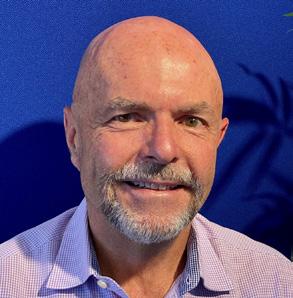
Editor RaeAnne Marsh
En Negocios Editor Edgar Rafael Olivo
Web Editor Jake Kless
Graphic Design Benjamin Little
Madeleine Bell
Tyler Butler
Monica Eaton
Jacob Fann
Sofia Fausette
Kathy Heasley
Dora Herrmann
Ross Honey
Mike Hunter
Marc Lamber
Brandi Lawson-Garlutzo
Clarissa Martinez
Dana Miller
Shirish Nadkarni
Danette Opaczewski
Ishan Patel
Misty Peckins
Stephanie Quinn
Lisa Rehurek
Kris Rudeegraap
Melissa L. Shingles

Jay Silverberg
Richard Tollefson
Austin Trautman
Bruce Weber
Brian Whorley
ADVERTISING
Operations Louise Ferrari
Business Development
Louise Ferrari
Cami Shore
Events Amy Corben
More: Visit your one-stop resource for everything business at inbusinessphx.com. For a full monthly calendar of business-related events, please visit our website.
Inform Us: Send press releases and your editorial ideas to editor@inbusinessphx.com
President & CEO Rick McCartney

Editorial Director RaeAnne Marsh

Financial Manager Tom Beyer
Office Manager Allie Jones
Accounting Manager Todd Hagen
Corporate Office InMedia Company 45 W. Jefferson Street Phoenix, AZ 85003
T: (480) 588-9505 info@inmediacompany.com www.inmediacompany.com
Vol. 14, No. 8 In Business Magazine is published 12 times per year by InMedia Company. POSTMASTER: Send address changes to InMedia Company, 45 W. Jefferson Street, Phoenix, AZ 85003. To subscribe to In Business Magazine, please send check or money order for one-year subscription of $24.95 to InMedia Company, 45 W. Jefferson Street, Phoenix, AZ 85003 or visit inbusinessphx.com. We appreciate your editorial submissions, news and photos for review by our editorial staff. You may send to editor@inbusinessmag.com or mail to the address above. All letters sent to In Business Magazine will be treated as unconditionally assigned for publication, copyright purposes and use in any publication, website or brochure. InMedia accepts no responsibility for unsolicited manuscripts, photographs or other artwork. Submissions will not be returned unless accompanied by a self-addressed, stamped envelope. InMedia Company, LLC reserves the right to refuse certain advertising and is not liable for advertisers’ claims and/or errors. The opinions expressed herein are exclusively those of the writers and do not necessarily reflect the position of InMedia. InMedia Company considers its sources reliable and verifies as much data as possible, although reporting inaccuracies can occur; consequently, readers using this information do so at their own risk. Each business opportunity and/ or investment inherently contains certain risks, and it is suggested that the prospective investors consult their attorney and/or financial professional. ©2022 InMedia Company, LLC. All rights reserved. No part of this magazine may be reproduced or transmitted in any form or by any means without written permission by any means without written permission by the publisher.
Brad Schoenberg is an experienced homebuilding executive focused on leading teams to be their best and maximizing results. Schoenberg has more than 25 years of homebuilding experience and has been with Taylor Morrison for the past eight years as its Phoenix division president.
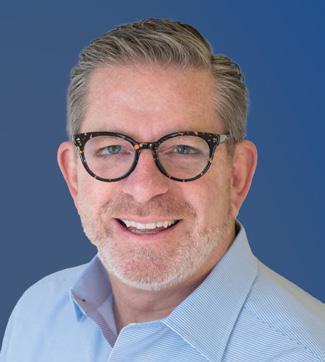

One of the nation’s largest homebuilders and developers, Scottsdale-based Taylor Morrison serves a broad range of consumers from coast to coast, including first-time, move-up and resort-lifestyle homebuyers and renters under its family of brands: Taylor Morrison, Esplanade, Darling Homes Collection by Taylor Morrison and Yardly. From 2016 to 2023, Taylor Morrison has been recognized as America’s Most Trusted® Builder by Lifestory Research.
As Arizona is experiencing a surge in population, we are seeing construction starts throughout the Valley to accommodate the increased housing need.
The housing market continues to serve as a significant driver of economic growth. At Taylor Morrison, we’re seeing that the housing consumer is evolving along with it, and that stability is coming to the housing market. According to our recent data, there has been a significant increase in the number of people who specifically desire new construction, which increased from 0% in 2018 to 25% in 2023. (Sample size: 30, 292 buyers.) In the Phoenix market specifically, new home sales now account for almost 30% of all single-family home closings. That’s up from historical norms of 13%–16%. The quality of new home construction as well as the energy efficiency being built in new homes has become a major differentiator in the homebuyer’s decision to purchase resale or new construction.
The relationship between housing and the economy generates a cause-and-effect discussion. With input from builders, city planners and economists, In Business Magazine explores the issue in this month’s cover story, “Home Economics: Does the Housing Market Impact Our Economic Growth?”
The rise of remote and hybrid work that was accelerated by the COVID-19 pandemic is another factor in the housing issue. As Jay Silverberg discusses in the guest column this month from global architecture, design and planning firm Gensler, “Office Conversion: Vacancy to Vibrancy,” vacated office space has potential for community spaces, hospitality — and residential.
Feature article “Jump-Starting and Scaling a Marketplace” alludes to the chicken-or-egg conundrum, as Shirish Nadkarni explains that without enough supply, there’s very little reason for consumers or buyers to show up, and without strong consumer demand, suppliers are generally reluctant to sign up. He shares several case studies in strategy that offer lessons to learn from.
The Roundtable feature this month also offers a case study, as Courtesy Automotive Group’s all-female team of finance directors discuss the power of female influence in a maledominated industry.
Also this month, In Business Magazine is profiling many top real estate companies and teams in the Residential Real Estate Top Leaders special section. Their experience and depth of knowledge in the residential market is spotlighted as we learn more about these talented professionals.

Timely, relevant, and sometimes even controversial, In Business Magazine offers content on widely varied topics in every monthly edition to help support our Greater Phoenix business community. I am pleased to lead this August edition, with its in-depth exploration of the housing market.
Sincerely,

As times become more and more strange to us, our economy, too, is causing many to second guess what is ahead economically. The home market in Greater Phoenix can also be a bit unknown at times. We are known for going from boom to near bust. But it turns out we have an awful lot going for us. While first-time buyers in other metro areas need to earn more on average, in Greater Phoenix they actually need to earn less year over year to buy a home, says one study. Job growth and other top global sectors and industry seem to want to be here. Our cover story delves into this “chicken or the
egg” concept of the housing market’s impact on our economy. It is a great read. I am pleased to have Brad Schoenberg lead this issue. Taylor Morrison is a longtime leader in the housing market in Arizona, and Brad is a veteran whose vast knowledge of the market makes him the perfect person to introduce this housing issue of In Business Magazine —Rick McCartney, Publisher
Manténgase informado sobre temas empresariales en español a través de En Negocios, artículos para los lectores de habla hispana en el área metropolitana de Phoenix. Visite inbusinessphx.com/ ennegocios para más información.
Stay informed on business topics in Spanish through En Negocios, articles for Spanish-speaking readers in the Phoenix metropolitan area. Visit inbusinessphx.com/ ennegocios for more information.

How is the availability or development of various housing product impacting economic development in your city?


City of Scottsdale
Sector: Government
Our region’s steady economic growth and diverse employment opportunities are continuing to draw businesses and individuals to the area. As a result, Scottsdale, like the rest of Arizona, is experiencing high demand for housing of all types.
The impact of this demand remains to be seen as the city’s ability to attract new businesses remains consistent and growth in certain industries is evident. The city’s economic development department also remains committed to supporting our existing businesses, knowing that most business growth in cities like Scottsdale comes from expansion of established businesses.
Scottsdale’s desirable mix of urban amenities and natural beauty will continue to attract companies and individuals who are looking for a business-friendly environment, strong economic base and skilled workforce. Our department will continue to monitor and plan for the many factors that can impact economic development within our city.
Choose Scottsdale choosescottsdale.com
Scott Cooper is currently serving as the City of Scottsdale’s interim economic development director after previously holding the position of business attraction manager. Cooper’s extensive 25 years’ economic development experience started in Iowa, where he served as CEO of a joint economic development/chamber of commerce organization for seven years. He relocated to Arizona to work for the City of Scottsdale’s Economic Development department from 2002 to 2007. Cooper has also led economic development organizations for the Town of Fountain Hills and, most recently, in Oregon.
Economic Development Director
Town of Gilbert
Sector: Government
In Gilbert, we are working collectively on ensuring sustainable housing options are a priority. As part of our Town’s 2018 General Plan, we identified the need for mixed-use housing Town-wide and developed zoning to meet those needs. Many of the outcomes as a result of that planning are coming to fruition in Gilbert today. As a result, we are seeing more businesses selecting Gilbert, which, in turn, has created new high-impact corridors such as Verde at Cooley Station and Rivulon, and the continued growth surrounding San Tan Marketplace. Award-winning communities have driven up demand for residency in the last two decades when the Town experienced explosive growth. We credit our community planners, developers and their undeniable foresight to predict the desired amenities and lifestyle attributes that would appeal to a wide range of demographics that make up Gilbert. As we continue to grow, our Town leaders will look into a housing study to monitor the ongoing challenges of the housing market not just in Gilbert, but within our unique position here in the East Valley.
Town of Gilbert Office of Economic Development gilbertedi.com
Dan Henderson has dedicated his decadeslong career to supporting the growth of businesses and communities across Arizona. Since Henderson joined the Town of Gilbert in 2007, he and his team have focused exclusively on business attraction, retention and expansion. Under his leadership, the scope of work now includes economic development, redevelopment and tourism, vital economic pillars that impact the long-term prosperity and resiliency of the community.
Mayor
City of Goodyear
Sector: Government
Goodyear is one of the fastestgrowing cities in the country, and we work hard to ensure the city remains a great place to live, with a high quality of life for our residents. That means welcoming businesses that offer good-paying jobs and having a variety of quality housing options for our residents, as well as amenities for recreation, shopping and entertainment. Jobs create a demand for new housing; new housing drives population; and population growth helps to attract the new retail, restaurants and entertainment that people desire.
The Goodyear City Council has been strategic in planning for diverse housing options to fit the preferences and needs of our growing community. People want to live in our beautiful city, and it is important that we have available housing for residents at all stages of life; from young professionals looking for an apartment to families looking for large single-family houses or retirees looking to downsize, Goodyear offers something for everyone. This thoughtful planning is instrumental to our success in growing into a complete city where people want to live, work and play.
City of Goodyear goodyearaz.gov
Mayor Joe Pizzillo was elected mayor in 2022 and has served on the Goodyear City Council since 2009. He brings more than 30 years of experience in state and local government budgeting and finance, including serving as Goodyear’s budget manager. He is also an adjunct professor of accounting and finance with Estrella Mountain Community College and Grand Canyon University.

ChatGPT4 is making me smarter and more productive! It’s like having a super smart friend sitting right next to me who has an encyclopedic knowledge of relevant data; the ability to answer complex questions; and the training to compose complete, stylized legal documents. Yet, this friend is often tone deaf, lacks perspective and is wrong from time to time.
In our personal injury practice, this technology is making us smarter by expanding our view of legal issues, challenging us to consider angles we had not before and giving us a tool to achieve even greater results for our clients.

ChatGPT4 helps us create more compelling arguments composed from the vast resources of the internet and tailored to the facts we input. And that is the beauty of ChatGPT: It can be loyal to the instructions we give it. The technology is on an entirely different level from Google search because ChatGPT4 can produce sourced final product rather than a just collection of topical articles and studies.
Yet, we are the lawyers, and as much as we may enjoy ChatGPT4’s ability to produce a solid draft in seven seconds compared to three hours, we have a professional responsibility to put our best foot forward with every clientrelated task. That means we must not rely on a ChatGPT4 composition, but rather, if we use it at all, consider it a draft that must be fact checked, source checked and heavily edited to include perspective and tone. We must also consider implicit and explicit bias in ChatGPT4’s
drafts. Most of all, it must be legally correct. Sometimes this technology produces unusable garbage, but the better we get at crafting and refining precise queries, the better the product becomes.
In our personal injury practice, we are using ChatGPT4 to perform certain functions of a paralegal. For example, without our inputting confidential information, the technology drafts comprehensive and compelling demand letters to insurance companies that we customize to help us illustrate the extent and impact of our clients’ injuries and why the defendant is responsible under Arizona law. These drafts may shed new light on an issue while being incorrect in other areas. That’s why we consider these letters and other ChatGPT4 product to be a start toward a final product.
So, too, with deposition questions for the defendant in a personal injury case. Prompted well, ChatGPT4 can analyze a fact pattern, consider Arizona law and produce draft questions that we refine before confronting a defendant during their deposition. We also use ChatGPT4 to draft sections of our website content focused on the types of services we provide. —Marc Lamber (marclamber.bio), a Martindale Hubbell AV Preeminent-rated trial attorney and a director at Fennemore who has been featured in national and local media, including the Arizona Republic, USA Today, ABC News, The Wall Street Journal, Forbes, the ABA Journal and many others
Here are the stories with the most views over the past 30 days (prior to press time) that were features in our In Business Dailies. The In Business Dailies hit email inboxes twice each weekday — at 9:30 a.m. and updated at 4:30 p.m. Sign up today at www.inbusinessphx.com/dailies-signup.
Technology & Innovation | Cover Story | July 2023
And how are we making it work?
by RaeAnne Marsh“Arizona’s tech community is a connected community,” says Sandra Watson, president and CEO of the Arizona Commerce Authority. “The camaraderie between entrepreneurs, whether you’ve been here for decades or just arrived this year, is as generous and welcoming as any in the world — a valuable asset for fostering innovation and collaboration.”
Technology & Innovation | inbusinessphx.com | July 14 2023
inbusinessPHX.com
In 2017, The New York Times labeled Arizona the place “where self-driving cars go to learn.”
With millions of test miles under their belt, today, those vehicles have graduated from development to safe deployment, placing Arizona at the forefront of automated technology.
Even George Jetson might be surprised at the selfdriving taxis, autonomous delivery services, and electric and hydrogen-powered semitrucks navigating the highways and streets of the Grand Canyon State.
Technology & Innovation | Feedback | July 2023
by Rebecca Clyde (Botco.ai), Mark Hanchett (Nxu), Sabina Rajasundaram (Codefy), Alexi Venneri (DAS Technology)
Q: What makes the Greater Phoenix area a strong region for the growth of technology companies?
Healthcare & Wellness | inbusinessphx.com | June 29 2023
inbusinessPHX.com
Blue Cross Blue Shield of Arizona announces it is expanding its strategy beyond health insurance and toward health solutions. AZ Blue has launched a new company, Prosano Health Solutions, Inc., to become an integral part of improving healthcare for Arizonans. Both AZ Blue and Prosano Health Solutions, Inc. share the same mission: To Inspire Health and Make It Easy.
A proponent of ChatGPT4, Marc Lamber believes attorneys who dismiss this technology will be left behind in its wake and, in fact, that it won’t be long before we have “Bot” jury consultants that read the biometric data of jurors to provide attorneys and judges with guidance as they present and decide cases. He anticipates being among the first to try that technology, too.
for 2023
Willmeng Construction has been named to Inc. Magazine’s annual Best Workplaces list for 2023. The Arizona-based commercial general contractor specializes in ground-up and tenant improvement projects for the public and private market sectors in the Southwest. The list is the result of a comprehensive measurement of American companies that have excelled in creating exceptional workplaces and company culture, whether operating in a physical or a virtual facility. willmeng.com
Cintas Earns Highest Safety Award
Cintas Corporation recently earned another safety and health commendation when its Phoenix-area Fire Protection Location D52 was honored with the Arizona Industrial Commission’s VPP Exemplary Award, which recognizes exemplary performance in their workplace safety and health program. The Phoenix-area location has twice been recognized with a Star designation by the Voluntary Protection Programs, the U.S. Occupational Safety and Health Administration’s workplace safety program. cintas.com
Koibito Poké Named a Top Emerging Franchise Local poke restaurant Koibito Poké has been recognized as one of the Top New and Emerging Franchises for 2023 by Entrepreneur magazine, at No. 131 Founded in 2018 by former MLB pitcher and three-time world champion Todd Stottlemyre, Koibito Poké is the leading Arizona poké restaurant influenced by traditional Hawaiian and Japanese flavors and ingredients. koibitopoke.com
Pita Jungle recently raised $1,873 for Arizona nonprofit Waste Not, whose mission is creating sustainable food systems that help people and the planet flourish. During the all-day event on National Pita Day, the local Mediterranean restaurant donated $1 for every pita sandwich sold at participating locations to the nonprofit. pitajungle.com • wastenotaz.org
Local breakfast concept Over Easy recently raised $14,692 for the United Food Bank, partner of Feeding America, following its annual Dollars for a Dozen fundraiser. In addition, every dollar raised contributed to 34,000 eggs donated and delivered to the nonprofit by Shamrock Farms. The United Food Bank provides hunger relief to people in the East Valley and eastern Arizona. eatatovereasy.com • unitedfoodbank.org
The most immediate effect of a lost RFP is the absence of new revenue.
Companies depend heavily on their proposal teams to secure opportunity wins on a consistent basis. New contracts equal new revenue, that’s obvious.
However, when a company loses an RFP opportunity, the ripple effect is felt throughout the company.
The annual average win rate for government RFP wins is less than 20%. In considering the time and resources that go into bidding, the costs add up. The cost of direct employee salaries in and of itself is significant.
However, the hidden costs can be just as significant, and include:
• Lifetime customer value — New contracts don’t just equal new revenue in the now; they also create future revenue potential.
• Hard expenses — Expenses spent completing a failed RFP can be a hard-hitting dose of reality. Hard expenses include direct
employee salary spend, technology, printing, supplies, travel and outsourced support.
• Market credibility — Whether we like it or not, reputation matters. When a company repeatedly loses business, they begin to lose precious market credibility.
• Competitors begin to own you — As confidence wanes within high-loss-ratio organizations, competitors gain an edge.
• Team motivation and engagement — When a team loses an RFP, organizations often lessen emphasis on rewarding and motivating team members. Continued losses create a domino effect of frustration, burnout and demotivation.
When considering these direct and indirect costs, the importance of bidding smart becomes imperative. The best course of action is to define the high-value client and develop assessment criteria to avoid bidding on lowpotential opportunities.
—Lisa Rehurek, CEOand founder of The RFP Success® Company (www.therfpsuccesscompany.com)
Recent studies have found that 7 in 10 large companies in the U.S. will be monitoring their employees in the next two years.
Careers and resume advice site StandOut CV reviewed which states are most likely to monitor employees according to Google data and determined just exactly what an employer is able to collate and monitor when using these tools. According to Google search data, this increase in companies engaging with employee tracking is well underway, with searches for “employee tracking software” up 122% nationally from 720 monthly searches in June 2022 to 1,600 monthly searches in May 2022.
Arizona led the way with the most annual searches per 1,000 employers in the state (589), with Texas in second (472) and Alaska in third (471). A total of 67 relevant search terms were considered in the research, including Google searches like “best employee monitoring tools” and “employee monitoring software” as well as 50 popular monitoring tool names like “ActivTrak” and “ClickTime.”
Time tracking was the most popular feature, with 96% of tools offering this, followed
by real-time activity monitoring (86%), attendance tracking (86%), and website/app usage (84%). Time tracking allows an employer to see how long an employee spends working on tasks; real-time activity monitoring provides a breakdown of what an employee has been working on and the exact files the employee accessed; attendance tracking shows when an employee is actively working on his or her device and when the time is spent as idle; and website/app usage shows which sites and apps were used and visited during the day, as well as the amount of time spent on each.
“To see that interest in monitoring employees in the U.S. is on the rise so sharply should be concerning for many employees who may not understand how these tools truly work,” observes Andrew Fennel, director at StandOut CV, who notes, “Monitoring can be good for business efficiency, however, recording video and audio will be considered a step too far by many employees who may look for a job elsewhere.” —Mike Hunter standout-cv.com/employee-monitoring-study standout-cv.com/usa
Video monitoring is now 42.42% more common on employee monitoring tools than it was in 2021 (38% in 2023 vs 21.88% in 2021). Seventy-eight percent of these “productivity” tools take screenshots of an employee’s screen, based on employer-set conditions.
Do you value your investments?

Let us protect what drives you!



Monica Samuels created Quasar Quantum Healing as the next wave in modern wellness. Founded in February 2021, QQH combines cutting-edge, non-invasive technology with yoga, meditation and nutritional guidance designed to detox the body at a cellular level and help achieve whole-body wellness. QQH serves those dealing with everything from skin conditions, joint pain and sports injuries to more complex issues like depression, anxiety, PTSD and traumatic brain injuries.
“I discovered this remarkable healing process when a close family member was facing mental health concerns,” Samuels shares. “It ultimately transformed her life and set her on a path of healing. After seeing the incredible results, I had to share this with members of my community and beyond.”
Starting the business during the height of the pandemic, Samuels says she was on a mission to share full-body healing. “During a time when many businesses were closed, I forged my way forward and knew that healing was especially needed during the time of the pandemic.”
Having been given what she credits as valuable advice that nobody truly knows what they’re doing and that running a business is a lot of trial and error, Samuels shares, “This has been helpful in maintaining confidence and faith in my vision and adapting to the ebbs and flows of the business. Nobody has
pursued our vision or taken the steps that we have taken before, so we are constantly learning and taking on new approaches.”
QQH offers avenues that are more natural and have fewer side effects than pharmaceutical drugs, plus, Samuels points out, pharmaceuticals often come at a high economic expense, so alternative methods could help people save money in the long run. “As mentioned above, I found these healing modalities as an alternative, effective way to help a family member who struggled with mental health,” Samuels says. “This center started as a space for teens to receive treatment and has grown to service a wide range of ages.”
—RaeAnne MarshQuasar Quantum Healing quasarquantumhealing.com
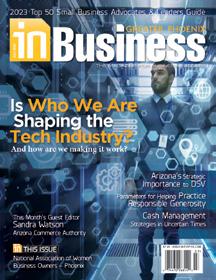
Biotech Consulting of Arizona, LLC provides consulting services to biotech and life sciences companies in the areas of consumer products, over-the-counter products, oral care products, applied genomics and molecular diagnostic products, operations laboratory support and technology evaluation as well as representing foreign companies in the USA.
The company was founded this year by Jaiprakash Shewale, Ph.D., who has more than 30 years of leadership experience spanning consumer (OTC drugs and cosmetics), oral care, applied genomics, molecular diagnostics and pharmaceutical industries. Dr. Shewale transformed innovative research to address unmet customer needs by commercializing some 20 products; these products were launched globally, on time and within budget. He is an inventor on 11 U.S.- and 17 Indianissued patents that led to the success of organizations where he worked. Additionally, he is an accomplished researcher in different areas of life sciences, has authored 118 peerreviewed research publications, has been editor for five special issues of Forensic Science Review and edited a CRC book.
“Many small and startup companies try to capitalize on the technical feasibility, proof of concept or prototype of a technology. However, commercial feasibility of the technology is an important activity to attract the investors,” Dr. Shewale explains.
Dr. Shewale has observed that many merger and acquisition proposals do not succeed and that one possible factor is that M&A teams, in general, focus on the financial aspects and potential of a company. He believes a preliminary technical assessment of the technology prior to initiating due diligence activity could increase the success rate of M&A. He founded Biotech Consulting of Arizona to help bridge these gaps — specifically, to bridge the gap between the technology and its commercial potential by way of either demonstrating commercial feasibility of a technology for attracting investors or conducting technical assessment at an early stage in the M&A process.
“Our mission is to provide exceptional professional and scientific support to organizations for achieving their corporate goals, thereby helping people to live healthier and longer lives,” Dr. Shewale says. —RaeAnne
Biotech
Marsh Consulting of Arizona, LLC biotechconsultingaz.com
The membership model is a business trend on the rise across many different industries, from subscription-based goods and services like Amazon Prime to members-only private athletic and social clubs like Soho House. From a business standpoint, having a membership model can help organizations grow by engaging with customers and retaining members long term. From a consumer standpoint, memberships are a way to create community, bringing likeminded individuals together and encouraging inclusivity, while offering exclusive access and customized programming.
One segment of the market where the membership model is quite revolutionary is the senior living industry. Many seniors are looking for more than merely a comfortable place to live when they “rightsize.” They are seeking a sense of community, socialization and a holistic lifestyle experience. A community membership can provide all of this, in addition to allowing for more customization and independence. Moreover, a membership model approach to senior living enables a higher level of price transparency, giving prospective residents all-in costs for more than just the cost of rent, including things like dining, entertainment, transportation, maintenance and housekeeping.
Revel Communities, a division of Scottsdale-based The Wolff Company, is a portfolio of 13 independent living communities across the Western U.S. Revel is leading the industry by launching a new resident membership model to give residents more autonomy and control over their living experience. Instead of paying “rent,” residents


pay for a resident membership. Revel resident membership plans are all-inclusive and the monthly cost includes a luxurious apartment home, access to premium onsite amenities, monthly dining credits, robust wellness and lifestyle programming, group and private transportation services, a 24-hour concierge, utilities, weekly housekeeping and maintenance. Additionally, Revel resident members receive Revel Travel Club access, a unique perk in itself. Through Revel Travel Club, residents receive the opportunity to stay at any other Revel community in their guest suite for up to seven nights per year at no cost. Within the new membership offering, there are four tiers of membership with various price structures and amenity offerings being piloted. This gives residents the ability to choose the number of membership points they’ll need to best suit their individual lifestyle. Points can be used for a variety of services throughout the community, including dining, special events, catered celebrations, salon and spa services, additional transportation charges, guest suite accommodations, special event tickets purchased through the onsite concierge, additional housekeeping and laundry services, handyman services, and printing and mailing services. Tiered memberships are already available at Revel Palm Desert and Revel Vegas, with additional communities launching in the coming months. —Danette Opaczewski, EVP and COO of Revel Communities(www.revelcommunities.com), a growing portfolio of dynamic independent living communities with best-in-class amenities and services spanning the Western U.S.
The Valley continues to experience significant population growth and with that comes more urban sprawl and housing developments. Construction is booming, but at what cost to local municipalities and businesses. Previously, developers could find creative solutions to meet water needs for new communities in outlying areas, but water shortages and sourcing challenges threaten to constrain new growth.
In a recent news conference, Arizona Governor Katie Hobbs spoke about limiting new housing in all outlying communities due to a dwindling water supply. At Vali Homes, we believe infill housing could be a solution to the Greater Phoenix area’s water woes. By focusing on infill, we utilize the resources already established.
Some of the benefits of infill housing include having an already established infrastructure. This includes enough ground water without having to find new sources, as is often the case for new construction. Other benefits of infill housing are the existence of nearby businesses and access to transportation.
Infill, however, should also be done responsibly and sustainably. With our combined expertise in architecture, science and nature, we take into consideration everything from our construction practices to the sustainability of our homes.

Vali’s construction methods consider the Phoenix environment and mimic nature, utilizing an approach called biomimicry to create the perfect building that is adapted for the Sonoran Desert. We have designed our buildings to last well over 100 years, using elements from the supremely well-adapted Saguaro cactus to create perfect air quality with a built-in carbon dioxide meter and air filtration system as well as passive house techniques. This allows the structure to be comfort-oriented with no temperature fluctuations. Homeowners can save roughly $800 a month as a result of lower utility and maintenance costs.
We use lower-carbon-impact methods of construction that are more efficient and durable. We also address toxicity levels in our construction practices by using natural materials such as sheep’s wool instead of oil-based synthetics. This creates a healthier environment for the construction worker, the community and the homeowner. —Austin Trautman, founder of Vali Homes (www.valihomes.com)
With a thriving economy and a surging population, Phoenix is cementing its position as one of the top real estate development hubs in the nation. Its sixth-place position in StorageCafe’s last-decade study is mostly achieved by way of its highly active industrial, self-storage and single-family sectors. storagecafe.com/blog/most-active-cities-for-real-estate-development
Christo and his family immigrated to the United States from South Africa in 2001, landing in Scottsdale, a new frontier that would bring fresh entrepreneurial challenges. Despite his many business achievements, nothing came close to the challenge of moving a world away. Terrifying, heart-stopping, exciting, a new beginning in the land of opportunity, riding the commercial real estate wave. “My family put their hopes and dreams in my hands and that was a huge responsibility.”
Some people are born entrepreneurs. And if there ever was one who fits that description, it is Christo Demetriades. He has spent most of his life and certainly his career in business for himself. It’s been a life of risks and rewards, highs and lows, challenge and achievement. As Demetriades says, that’s par for the course.
But Demetriades’s entrepreneurial life is anything but par. Born in Johannesburg, South Africa, Demetriades, even as a child, had an entrepreneurial edge. Before he graduated from WITS University, he started his first business with $20,000, a lifetime of savings. The company was Cosmotrade International, and for a solid year this fledgling import-export business was draining Demetriades dry. “There were many days when we struggled to make a payroll,“ Demetriades relates. “I didn’t know what I was doing but, after a year, I knew what not to do, which was persisting and expecting a different outcome.
That’s when Demetriades decided to pivot and import polyethylene for the growing South African plastics industry. The first of many achievements, Cosmotrade quickly became one of the largest importers of polyethylene in the country by spotting a growing need and finding reliable partners that could scale.
“While the business generated a lot of cash, I knew that wealth-building took acquiring appreciating assets, so I decided to expand into investment banking.” Demetriades acquired his first restaurant, Bourbon Street Café, then Flame Burgers, creating FoodGro, a multi-concept franchise company. More business acquisitions under the name LeisureNet followed, including Health&Racquet Club, a 25-unit mega health and fitness concept. When LeisureNet went public, the value was $75 million. With all that achievement, in 1994 Demetriades won Young Businessman of the Year.
Demetriades’s success allowed him to see the world. He could have lived anywhere but chose Arizona as his new home because he felt it offered the best entrepreneurial opportunity. By using his abilities to find deals (this time in real estate), assemble investors and negotiate win-win agreements, he was able to repeat his success.

Then came the Great Recession of 2008. But, as real estate values everywhere plummeted, Demetriades decided to chase the trend down. “No banks were lending money, and investors had dried up, so I began selling assets at a dramatic loss or borrowing against them just to stay afloat. I was prepared to do whatever it took to save my name, my investors, and my business.”
It’s hard to believe that getting a family dog could spark a turnaround, but that is what happened. “In August of 2016, I woke up and said to my wife Leighanne, ‘We are getting our son Michael a dog for his birthday, and this dog is going to change our lives.’” Soon after, Georgie took up residence and, surprisingly, life took on renewed positivity and energy.
During the Great Recession, the United States lost an estimated $16 trillion in asset value. This included losses in real estate, stocks, and other financial assets.
First, Demetriades partnered with Trefethen Advisors a boutique investment banking firm, which gave him a platform, purpose and capital. He was doing deals again, felt part of the business world, and was getting back on his feet. “Getting into the deal flow again brought me back to life,” he recalls. That charged his entrepreneurial spirit, so, in 2017 he opened Taphouse Kitchen — and he was back in the food business. A year later, LunchboxWax landed on his desk and, with an abundance of wisdom and energy, he put an investor group together in 24 hours and closed the deal. Two years later, they doubled the size of the business, and a year later sold it for a profit.
“When you’re doing something you’re born to do, you have to keep going.” By being transparent with investors, putting them first, and striking new partnerships that benefited everyone involved, Demetriades began to reclaim his footing. People believed in him because the opportunities he brought forward made financial sense and had significant upside.
Most recently, Demetriades, along with franchising veteran Heather Elrod, started Conscious Capital Growth, an acquisition and investment growth accelerator firm focused on the franchise business sector, which he believes has the potential to be a billion-dollar company. Demetriades’s direct and transparent communication style inspires belief, then his actions and results affirm it. His motto is, “Surround yourself with the best people. Say what you’re going to do and do what you say.”
In 2023, Demetriades was honored by Entrepreneur’s Organization as Entrepreneur of the Year. “This award symbolized far more than the businessman of the year award I had won 28 years earlier. It was more poignant because of what I had lived through,” he says. It is a testament to his philosophy: “If you were successful once, you can be successful again, no matter the circumstances. Use your smarts, use your wisdom, and do the work.”
Conscious
Capital Growth ccgro.com
If you have news to share about the semiconductor industry in Arizona, email us at semiinsights@ inbusinessphx.com
In an unprecedented partnership, Advantest Corporation, a leading semiconductor test equipment supplier, Arizona State University and global semiconductor company NXP® Semiconductors have come together to revolutionize the field of test engineering education. The collaboration aims to introduce a pioneering test engineering course at ASU, aptly named “EEE 522 Radio Frequency Test,” marking it the first of its kind in the industry. The course’s curriculum, initially developed by ASU’s esteemed faculty in the Ira A. Fulton Schools of Engineering, has been further enhanced through the expertise of Advantest and NXP, which contributed laboratory experiments to enrich the learning experience. This remarkable course will be offered annually, promising to shape the future of semiconductor testing.
The impetus for this groundbreaking initiative arose in mid-2022 when Advantest and NXP recognized the growing demand for test engineers amidst the surge in wafer-fab construction in Arizona, a region already home to numerous advanced chipmaking plants. Identifying a gap in local university engineering programs that failed to cater specifically to the needs of the semiconductor test industry, Advantest and NXP approached ASU with their vision, receiving an enthusiastic response.
Raghu Maddali, senior director of test engineering at NXP and one of the course’s original developers, emphasized the importance of collaboration between industry and academia, stating, “This course is a great example of what can happen when there’s a true collaboration between industry and academia. It came to fruition in a relatively short time, thanks to the dedication and commitment of all involved.”
To ensure the success of the course, both Advantest and NXP contributed not only their expertise but also valuable resources. Advantest provided a cutting-edge V93000 SoC
test system, which was installed at ASU Research Park in Tempe. Experts from NXP and Advantest’s engineering teams volunteered as lab supervisors, guiding students through practical experiments designed to reinforce classroom concepts and familiarize them with an industry-leading ATE (Automatic Test Equipment) platform.


Course professor Sule Ozev, Ph.D., a seasoned educator at ASU, expressed her enthusiasm for building the curriculum from scratch with the assistance of Advantest’s application engineering team. She stated, “It’s exciting to be part of a program that will provide the semiconductor industry with a new generation of much-needed test engineers.”
Offered through ASU’s School of Electrical, Computer, and Energy Engineering, which falls within the prestigious Fulton Schools of Engineering, the RF test course delves into current production test schemes for mixed-signal and RF circuits. It covers topics such as the economics of production testing, recent research techniques to reduce test costs, defining test conditions and flows, optimizing test programs, interpreting measurement data, identifying manufacturing issues and automating the testing process.
Paul Hirsch, senior global account manager at Advantest, emphasized the remarkable journey that began as an idea between colleagues and transformed into a tangible means of providing real-world training. He stated, “What started with an idea shared between two colleagues quickly blossomed into a tangible means of providing real-world training that will help prepare students for high-demand positions while further supporting our industry and Arizona’s economy.”
With a significant presence in Arizona, both Advantest and NXP are deeply committed to the region. They will continue supporting the course and potentially contribute to future additions to the program, further solidifying their dedication to fostering industry-academia collaboration and driving Arizona’s semiconductor industry forward.
Advantest Corporation advantest.com
Arizona State University asu.edu
NXP® Semiconductors nxp.com



Bold and exciting advancements are happening in the Grand Canyon state. Cuttingedge companies are launching, testing and scaling new technologies in Arizona. Our culture of innovation, highly skilled talent, lean regulatory environment, and aff ordable operating costs provide an ideal platform for business growth and success. The state has announced investment from industry leaders including Blue Origin, LG Energy Solution, Sion Power, Benchmark, TSMC, JA Solar and more. Ranked top fi ve for fastest growing state, it’s clear why people are flocking here. Beyond being a place where you can achieve your professional goals, Arizona provides an unmatched lifestyle that allows you to achieve your personal goals. It’s this perfect balance that makes life better here.

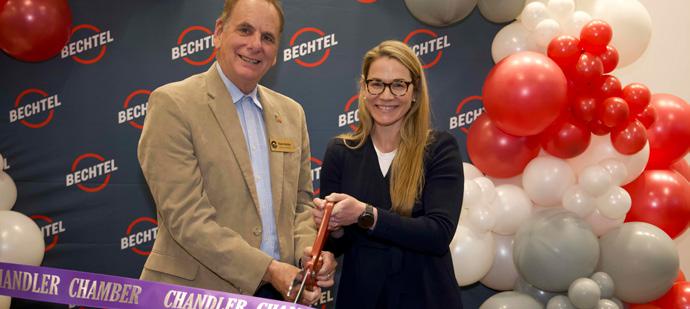
Bechtel, a leading construction and engineering company in the United States, recently announced plans to establish a new office in Chandler, Arizona. The move aims to strengthen Bechtel’s Manufacturing & Technology global business unit, catering to semiconductor, batteries, and battery materials market customers.
The office opening occurred on June 27, 2023, with key business partners and government officials in attendance. Located at 3133 W. Frye Road in the Price Corridor, the office occupies 8,000 square feet of space and accommodates professionals from engineering, procurement, project controls and construction management disciplines.
Catherine Hunt Ryan, president of Bechtel’s Manufacturing & Technology global business unit, expressed excitement about the Metro Phoenix area’s thriving business and high-tech landscape. Ryan emphasized the talent pool available, enabling Bechtel to attract top professionals for designing and building projects. The strategic focus on Chandler will strengthen collaboration with partners engaged in the semiconductor, battery and battery materials markets.
Chandler Mayor Kevin Hartke welcomed Bechtel, acknowledging the city’s reputation as a manufacturing and technology hub. He expressed confidence that the new office would support economic development and enhance Chandler’s appeal to businesses.
Bechtel’s presence in Chandler will complement its existing U.S. and international office locations, including Glendale, Arizona. The expansion underscores Bechtel’s commitment to customers and its growing influence in the semiconductor and battery industries.
As Bechtel settles into its new Chandler office, it is poised to play a pivotal role in shaping Arizona’s manufacturing and technology landscape. Leveraging its expertise and reputation, Bechtel’s presence promises to fuel innovation, collaboration and economic growth in the semiconductor and battery sectors. —Stephanie
QuinnIn an exciting development for the semiconductor industry, Foresight Technologies has unveiled its plans to establish a new Center of Excellence for high-purity fluid and chemical system equipment production in Tempe, Arizona. The announcement has generated significant buzz and is set to revolutionize the manufacturing landscape in the region.
The Foresight Technology Center aims to foster strong partnerships with original equipment manufacturers and semiconductor fabs, specifically focusing on supporting developing and producing high-purity fluid delivery equipment for the semiconductor and chemical markets. This strategic move will position Foresight Technologies as a key player in meeting the growing demand for cuttingedge semiconductor equipment.
The center will encompass Foresight’s existing 80,000-square-foot Tempe operations and an additional 100,000-square-foot facility, which is slated to be fully operational by the third quarter of 2023. The facility’s expansion will create 250 new jobs, effectively doubling Foresight’s current employee headcount and injecting vitality into the local economy.

Jeff Hull, chief executive of Foresight, expressed his enthusiasm about the project, stating, “We are excited to make this significant commitment to support the global semiconductor market. Foresight has been based in Arizona since 1995 and experienced continued growth due to our relationships with leading semiconductor OEMs and our proximity to the largest concentration of semiconductor fabs in the U.S. Growing and expanding our capabilities at our Tempe site was an easy choice.”
The Foresight Technology Center will provide high-purity equipment integration and fluid acceptance test facilities for leading edge OEM modules, slurry systems, chemical distribution, valve manifold boxes, fab infrastructure and other plastic-based equipment. This comprehensive offering will cater to both U.S. and international customers, allowing them to enhance their production capacities, reduce costs and receive localized support for their U.S.-based fab customers while preserving strategic end-customer relations and product intellectual property.
components, subsystems and equipment has contributed to its reputation as one of the fastestgrowing companies in the industry. By vertically integrating all core manufacturing services, Foresight has delivered products faster, maintained complete quality control and offered competitive pricing.
The expansion of Foresight Technologies is not only a boon for the company but also for the community of Tempe. Mayor Corey Woods expressed his appreciation: “Foresight has been a vital technology leader in our community for years. Not only does Foresight Technologies bring high-quality jobs to our city, but their international reputation for excellence enhances our city’s status as a technology magnet.”
This expansion aligns with the overall momentum of Arizona’s semiconductor industry, with recent announcements from other key players such as Moov and Cactus Materials in Tempe, Edwards in Chandler and Benchmark in Mesa. The establishment of the Foresight Technology Center further solidifies Arizona’s position as a premier destination for advanced semiconductor operations.
Sandra Watson, president and CEO of the Arizona Commerce Authority, emphasized the positive impact of Foresight’s expansion, saying, “The Foresight Technology Center will expand our semiconductor supply chain while creating skilled jobs. We are grateful to Foresight for its continued commitment to Arizona, furthering the state as a premier destination for advanced semiconductor operations.”
Bechtel bechtel.comForesight Technologies, founded in 1995, has already established equipment manufacturing sites in Tempe, Arizona, and Penang, Malaysia. The company’s strategic focus on high-purity chemical
With the establishment of the Foresight Technology Center, Foresight Technologies is poised to significantly contribute to the semiconductor industry and the local community in Tempe. The increased production capacity, job creation and enhanced supply chain will fuel growth and innovation, solidifying Foresight’s position as a leading provider of semiconductor chemical equipment. —Stephanie Quinn Foresight Technologies foresighttech.com
The Foresight Technology Center aims to foster strong partnerships with original equipment manufacturers and semiconductor fabs, specifically focusing on supporting developing and producing high-purity fluid delivery equipment for the semiconductor and chemical markets.

Businesses may be questioning how effective their benefits are at attracting and retaining top talent, and whether everyone on the team has equal access to healthcare.
With costs on the rise, employees are jumping ship for higher wages and better benefit packages. That’s why employers are turning to new solutions like Paytient’s Health Payment Accounts to attract and retain valuable employees while ensuring they have access to affordable care.
Employers determine the credit allowance, max repayment terms and approved spending categories (medical, dental, vision, pharmacy, mental health and vet care).
With the 0% APR Paytient card and connected app, employees can pay for care whenever they need it and split costs into a series of manageable payments. For example, a $250 urgent care visit can be turned into 10 payments of $25 or five payments of $50. Payments are automatically deducted from payroll, or a linked bank account, like an HSA.
Employers appreciate 30% lower turnover among Paytient cardholders and measurable improvements in health equity. The card is 16% more likely to be used by employees who live in below-average income zip codes. Plus, the card supports plan migration to higher deductibles, or HDHPs, lowering costs while ensuring access to care.
Employees love it so much that they’ve given the service 4.8 stars on Trustpilot and a Net Promoter Score of 90+ with reviews like: “I think in general this is a great service. It makes paying for medical and dental expenses less stressful. The automatic deductions from my paycheck aren’t even noticed and I always am able to afford going to the doctor, the dentist, and don’t have to worry about pricey medications. My son recently had an asthma medication that was over $200 but I was able to pick it up and pay for it without issue.”
—Brian Whorley, founder and CEO of Paytient (www.paytient.com), which works with employers, insurers, brokers and health systems to provide health payment accounts to offer people the power to pay out-of-pocket healthcare expenses
The lessons of delivering quality healthcare to LGBTQ+ individuals transfer to any company There is no doubt that today many companies are striding toward becoming places where all people are welcome — employees and customers alike. The focus on diversity, equity and inclusion is especially meaningful to entities like ours that have made inclusivity our life’s work. Our experience providing quality healthcare to LGBTQ+ individuals at Spectrum Medical Care Center for more than two decades has inspired ideas that any company on a path toward a more inclusive environment will appreciate.
During our initial years as an HIV clinic, we realized how underserved the entire LGBTQ+ community was and expanded our services to support the LGBTQ+ community as a whole. Our goal remains the same — to serve a greater portion of the community, who would otherwise be underserved or unserved entirely in the healthcare space. Even for us as experts in serving the LGBTQ+ community, when groups like LGBT Capital report LGBTQ+ purchasing power in the U.S. to be in the trillions, the numbers feel surreal. When the U.S. Census Bureau documents more than 980,000 same-sex households in the U.S. and ranks the City of Phoenix ninth in the nation for highest percentage of same-sex couples in a 2021 American Community Survey Brief, to us as healthcare providers it means there is so much more outreach and health education needed.
With today’s heightened understanding of the importance of inclusivity, we know others see the opportunity, which makes sharing what we’ve learned along our more than 25 years’ journey all the more timely.
Adapt and lead the conversation in our industry. Historically, LGBTQ+ healthcare focused on HIV and AIDS. Medical innovation made HIV manageable, found ways to keep it undetectable and untransmittable (U=U), and discovered medication prevention (PrEP). We knew it was important to lead healthcare changes due to these innovations, but to also broaden our value proposition. As a trusted entity, we are in a position to lead the narrative and to shape the future of holistic, preventive healthcare customized for our population of diverse LGBTQ+ patients who have healthcare needs beyond HIV services.
Recognize the value of reputation. Already established as a trusted healthcare provider, we
fill a resource gap by offering objective counsel as industries continue to bombard LGBTQ+ patients with information about new medications and treatment innovations. Our reputation earns us a position as educator, one-to-one advisor and thought leader among our healthcare peers.

Be deliberate in hiring. Building a workforce that represents the community we serve speaks more than the best written, well-intended diversity and inclusion statement. Our hiring and screening process at Spectrum Medical Care Center is purposeful. Our team is led to embrace the responsibility of being an extension of our brand, which means treating our patients with the best healthcare enveloped in respect, understanding and dignity.
The rewards for companies going on this journey are becoming more recognized. Prioritizing the LGBTQ+ community communicates a commitment to diversity and inclusivity, showing that the company supports all customers. In a competitive landscape, embracing the LGBTQ+ community can be a differentiator, setting the company apart from others that haven’t recognized the potential of this market. Demonstrating inclusivity, authentically, leads to brand loyalty among LGBTQ+ individuals who support companies that are consistently active in their community, leading to word-ofmouth recommendations and repeat business. Additionally, attracting diverse talent fosters innovation, and can lead to improved employee satisfaction and retention within the organization.
Still, getting to the rewards takes a thoughtful approach. Businesses should think beyond PRIDE Month, as inclusion is a “feeling” and a way of being that requires sustained action for authenticity. LGBTQ+ individuals are not monolithic; it’s important business leaders avoid stereotypes and, instead, become familiar with the diversity within the community. Groups like the Human Rights Campaign can help other businesses learn more about LGBTQ+ terminology and culture.
It is natural to feel uncertainty when navigating new territory. We’ve found it’s important to start from a place of truth. When in doubt, we seek counsel from trusted members of the community. In the end, when it comes to designing a culture of inclusivity, there can be no fault if it’s built on a foundation of authenticity. —Brandi LawsonGarlutzo, interim executive director at Spectrum Medical Care Center (spectrummedicalcareaz.com)








Honor is what motivates our team of dedicated healthcare professionals. Through passion and purpose, we come together to ensure every patient is provided with the best possible care. honorhealth.com











In today’s world, the nuances of social media can make or break success in business. This is why so many owners tend to play it safe on social platforms or stray away from using this medium altogether. However, social and digital media today is the equivalent of hanging a flyer on a coffee shop bulletin back in 1995 — necessary.
For those looking to grow a business through social and digital media marketing, here are some tips:
• Choose the right platform: Every social platform has a unique audience. This fact means a business’s content strategy must differ across each platform. LinkedIn produces business-to-business content while Facebook and Instagram follow a business-to-consumer model. Additionally, content creation shouldn’t be all about what a business wants to create; the audience and what they want to see should also be considered.
• Take advantage of paid advertising: Paid advertising is always important, but the strategy changes based on the company’s size. While large corporations can put millions behind one Google or Facebook ad, a small business can’t financially compete with that, which results in paying for ads that don’t reach the intended audience. Instead, mom-and-pop businesses should focus on a 30-, 60- and 90-day organic lead generation strategy and then utilize a small budget on paid ads to retarget those leads found organically.
• Consistency is key: It’s important to remember that social posting needs to be consistent. Many business owners try to handle social media independently, but with so many other responsibilities, posting becomes inconsistent, leading to less audience engagement.
• Start with personal connections: No one is going to give a business a better review than family and friends. Entrepreneurs should look to friends, family, neighbors, etc., to help kickstart any business. This provides a level of trust that results in positive feedback and helpful critiques and is an easily accessible arsenal of supporters to organically promote the business whenever possible. —Jacob Fann, founder of Fanntastic Media (www.fanntatsticmediallc.com), which helps clients with digital marketing strategy, lead generation, content creation and more

From the days of dial-up internet to multi-gig speeds of today’s networks, the internet has drastically changed. Users can choose their home setup based on the number of devices they have and the speed they desire. Regardless of this choice, users need to ensure they are getting the best out of their Wi-Fi. Individuals can take a few simple steps at home to ensure optimal Wi-Fi experience.
Having a basic understanding of what Wi-Fi is and how it works can help users better understand their home’s internet needs and adjust their set-up accordingly. A Wi-Fi network is a wireless gateway to the internet. This connection comes from a wireless router that is often connected directly to a modem. The speed of this connection will depend on the internet speed the user subscribes to, hardware capabilities and placement of the router. Bandwidth refers to the amount of data the network can handle at once.
A single router can handle only so many devices without slowing down. Each device impacts Wi-Fi efficiency differently. Streaming on 4K TVs and downloading updates for gaming devices will have a high impact on the home Wi-Fi compared to smart light bulbs and thermostats. Users should take an audit of their home devices and understand how much bandwidth they need.
It’s not unusual to have one router covering an entire home, but this doesn’t always provide a great internet experience in every room. Devices might be placed in areas with poor Wi-Fi signal, resulting in interruptions and degradation of the Wi-Fi network. Users can solve this issue by setting up a mesh network, which combines two or more access points and creates a seamless Wi-Fi experience across their whole home. Placing an access point halfway in-between the Wi-Fi router and poor Wi-Fi area will improve the overall Wi-Fi experience.
Users who have a dedicated office or a gaming room might want to consider connecting stationary computers and gaming consoles to a router via an ethernet cable for a dependable connection. Wired devices aren’t susceptible to Wi-Fi interference and typically receive better speeds than Wi-Fi. Wiring high-utilization devices can often lead to better performance for
Wi-Fi-connected devices as well, since it reduces congestion and opens up the airwaves for devices dependent on Wi-Fi. This also can work well for streaming devices like 4K TVs.
There are three different Wi-Fi frequencies:
• 2.4 GHz: Most common across all Wi-Fi devices and routers. 2.4 GHz is typically heavily congested due to interference from neighboring devices and other consumer electronics.
• 5.0 GHz: Most modern smartphones, laptops and Wi-Fi routers support this.
• 6 GHZ: Recently launched for public use and available only in high-end Wi-Fi devices.
All three frequencies have pros and cons. A 2.4 GHz spectrum usually reaches more areas and offers wider coverage. However, it has considerably less bandwidth than a 5.0 GHz spectrum, meaning streaming TVs may have to buffer. The 5.0 GHz offers less range but can power many devices at once, so smartphone and laptop users won’t have to worry about interruptions with this frequency. 6 GHz offers even better speeds than 5 GHz, but at the expense of coverage area.
Users typically do not have to make the decision about which frequencies to use, as long as the Wi-Fi SSID and password are the same across all frequencies. Most Wi-Fi devices will auto-connect to the appropriate frequency best suited for the device and its intended use. For example, while a device may be connected over 5.0 GHz spectrum, it will automatically switch to 2.4 GHz when it’s on the outer end of its signal range.
The internet and the devices that use it continue to change, and home Wi-Fi needs to keep up. —Ishan Patel, who leads consumer premises equipment (CPE) Product Management at Google Fiber (fiber.google.com/bb) and has more than 10 years’ experience in consumer mobility and fiber industries, launching a number of products, services and platforms
Cybersecurity training, as well as the purchase of cybersecurity solutions/services (61% each), are the most popular IT investments among U.S. businesses this year, according to new research about cybersecurity investments by NordLayer, a network security solution for businesses. nordlayer.com/blog//best-practices-cybersecurity-budget-research-guide


Finding opportunities to lower expenses is part of running a business. So is keeping your business comfortable for your customers and employees. With the SRP Bring Your own Thermostat Program™ (BYOT), you can do both with ease. When you enroll in BYOT, you can receive energy-saving smart thermostats for free and get paid for each one you install. You can even use the smart features of your thermostat to monitor energy usage and monthly savings. BYOT doesn’t just help your business, it also helps keep Arizona’s grid reliable by automatically adjusting thermostats during a few conservation events a year.
Find out more about the benefits of SRP’s BYOT program at srp.net/bizbyot.

 by RaeAnne Marsh
by RaeAnne Marsh
observes Randy Bury, who has more than 25 years’ experience in home building, land acquisition and development and is founder and owner of Moderne Communities®, an Arizona-based real estate investment and development company. “I believe approximately 65–70% of GDP is consumer spending, of which homebuilding and construction is the largest percentage of that spend — so the impact is significant.” Citing Automatic Data Processing, Inc.’s June report of approximately 497,000 new jobs and noting that 97,000 are in construction, he adds, “While other industries are experiencing layoffs or ‘right sizing,’ builders are hiring and they aren’t laying people off because it is tough to re-hire. It is also significant to note that housing starts are up year-over-year.”


“When the housing market is strong, typically economic growth is strong,”
From an economist’s point of view, it’s not the housing market that affects economic growth and the building of business, but, “It’s the inverse,” says Dennis Hoffman, Ph.D., professor in the economics department at Arizona State University’s W. P. Carey School of Business and director of its L. William Seidman Research Institute. It is economic growth and building of business that affect the housing market, and Dr. Hoffman points out that Phoenix and Arizona have been growth leaders for decades, magnets for people and new businesses. “With that ongoing influx, there is an unrelenting demand for housing,” he says, adding, “Historically, abundant land and affordable labor have kept costs low, so below-average housing prices did help promote the state as a great destination.”
While he believes housing costs have to impact at some level — such as people buying smaller homes and spending less on furniture and fixtures — Dr. Hoffman says growth appears to be strong in the state. “Significant business in-migration continues at a brisk pace.”
In the daily machinations of the market, however, housing does affect the economic picture.
For instance, John Carlson, president of Mark-Taylor Companies, the leading developer, owner, and investment manager of luxury multifamily communities in Arizona and Nevada, cites the Arizona Apartment Market Analysis that Elliot Pollack & Company produced in 2019: “It was estimated in 2018 that the apartment industry generated an annual impact of nearly 22,000 jobs, $695.9 million in wages and $3.8 billion in annual economic output each year.”

Observing that housing and the cost of housing has a huge impact on any local economy, Butch Leiber, president of the Phoenix REALTORS board of directors and an active broker, explains, “When there’s growth in the market, it creates jobs in construction, infrastructure and service jobs as well.” Noting that affordable and available housing can create opportunities for people to move to a
city, he says, “Phoenix, and Maricopa County, continue to lead cities with population growth due to an abundance of housing and job opportunities.”
Tempe’s deputy economic development director, Maria Laughner, sees housing affordability encouraging economic growth because businesses have an easier time attracting a workforce. “If workers can live close to where they work, they can rely on various modes of transportation, which provides more workforce stability. If workers cannot live close to where they work because there is scarcity in affordability, they will most likely be dependent on automobiles, which can create transportation instability.”
Laughner explains that an increase in housing units overall provides stability for businesses to locate or expand into a market because they know they can attract workforce nationwide who can relocate to the area. “Workforce is the first priority for businesses, so companies do not expand in cities that do not have growth,” she says. “They need to be assured that they can build their business in a city before they invest in capital and space. Housing availability is the primary indicator of workforce strength.”
Recent years have brought what Tim O’Neal, president and CEO of Thrive Services Group, characterizes as “unprecedented fluctuations in the housing market.” As head of a not-for-profit organization whose mission to eradicate poverty includes finding creative and effective solutions in housing, O’Neal says, “CEOs from various industries share the same concern, as our current housing market poses challenges in recruiting and retaining talent.” Believing that sustaining businesses and essential services at optimal staffing levels is essential for thriving communities, he says, “To achieve stable economic growth and attract businesses, we must consider the needs of the entire community, including low to mid-income earners who require employment, and affordable housing options.”
“Currently, there is a misalignment of housing relative to what people are looking for,” says Chris Jacques, planning director for the City of Peoria. He emphasizes the importance of being able to offer housing to different lifestyle options and different income segments “because you want to be able to attract businesses that have places for the workforce to live in close proximity.”
Acknowledging the challenges brought on by exceptional growth — among which are water availability, schools and transportation — Julie Hancock, managing director and co-owner of Camelot Homes, believes good city planning can help mitigate those challenges. But she brings up an additional challenge: “Unfortunately, many people conflate ‘planned growth’ with ‘no-growth’ — and ‘no-growth’ environments have created unintended consequences that worsen our challenges.” Describing the consequences of city councils acquiescing to demands of no-growth groups and voting against infill re-zoning for higherdensity projects even when they conform to their city’s general plan, she points out that growth is forced further to the outskirts of the city — which causes more traffic, air pollution and higher prices for homes in central locations. “People need and want to live in areas close to their jobs, but land and home prices and higher interest rates are compounding the problem. This, ultimately, increases urban sprawl and decreases quality of life for all,” Hancock says.
To that point, Jacques says Peoria’s general plan tries to forecast the areas where the city planners believe there will be a lot of intensity of employment and business, and tries to provide areas for different types of housing in proximity to that hub. “We try to do that in certain strategic areas around the city,” he says. “Mainly, it’s about trying to plan for those appropriate areas for different housing types.”
According to Jennifer Stein, director of Peoria’s economic development services department, the city is experiencing strong activity from both its target markets and generated leads. She reports a lot of interest on the industrial, advanced manufacturing side of the house, thanks to Taiwan Semiconductor Manufacturing Company and the supply chain that’s interested in being in close proximity.
“Peoria prides itself on being a full-service city with amenities and opportunities, and that includes diverse housing, ensuring that we have housing products for all — single family, multifamily, executive house, whatever suits your needs,” Stein says, explaining that Peoria, for a long time, has been “planning strategically in conjunction with master-plan developers to provide incredible neighborhoods.”
Emphasizing the importance that housing product be distributed fairly uniformly throughout the city, Jacques describes three major projects. Peoria Place, a vacant area close to Peoria’s downtown core, was rezoned a couple of years ago — in line for what the general plan had allowed for it — to allow a mix of housing types to help support the rejuvenation of downtown that includes multifamily, build-torent and more urban-style mixed-use development. The Park West area, long envisioned for mixed-use, is seeing new restaurants and entertainment options add to the retail and entertainment already in place, and Jacques says, “There was some existing multifamily,
but over the last couple of years, we’ve encouraged additional multifamily. We’re trying to create the critical mass where you have housing in close proximity to jobs and services.” And for Vistancia, long envisioned as a major hub for employment users, high-tech, business park, retail, hospitality and residential, the developer is asking for a zoning amendment to allow an additional increment of housing specifically focused in that area. “Again, trying to create that mixed-use, that urban core,” Jacques says. “We have opportunity for different housing types and an environment where people can walk to work, walk to shops.”
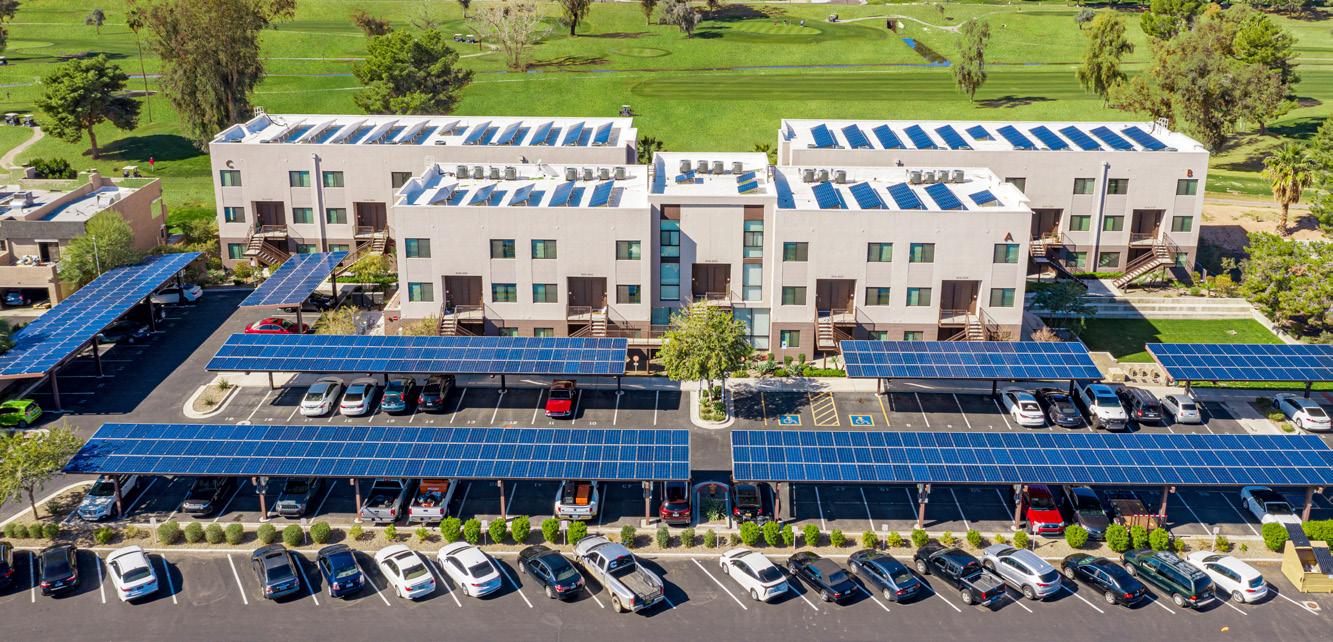
Laughner describes Tempe as taking “an all-in approach,” saying, “We are pursuing multifamily construction throughout the city and proactively working with builders to encourage construction.” To that end, Tempe is issuing RFPs for redevelopment of city-owned land into mixed-use multifamily projects. “We are actively working with the housing authority on funding to acquire and build affordable multifamily wherever we can. And we are actively upzoning sites to streamline the process for private landowners to build multifamily.” This includes affordable housing, which Laughner says is mostly north of U.S. Route 60, due to transportation and development options, “though we highly encourage it along our TOD on Apache Blvd due to transportation options.”
Another factor comes out of the recent pandemic. Leiber, observing that many people learned during COVID that they could just as effectively work from home, so there’s now an abundance of office space available, says, “There is a movement trying to find developers to convert some commercial office and retail space to affordable housing.” Changes like that will require partnerships with local governments, developers and investors, which Leiber sees currently happening. “This is another potential shift the National Association of Realtors is behind and actively supports through lobbying,” he says.
O’Neal points out that, while we often focus on macro-level aspects like land and real estate development, it is ultimately the people within our communities who drive the economic engine.
“To ensure successful economic development,” he says, “it is crucial to address the pressing questions surrounding housing.” Without affordable housing solutions, communities struggle to attract diverse businesses and employment opportunities. “Accordingly, housing stability and employment stability are intricately linked.”
The economic growth that creates jobs and attracts people to move into our market puts pressure on home prices, says Ed Modus, founder of Phoenix-based MODUS Companies, which is known as one of the country’s leading developers of Net Zero communities — and this is compounded by high interest rates, which make it difficult for many to buy homes or move to a new one. Noting that the interest rates have, moreover, caused many builders to pull back on multifamily housing, he says, “These two things will combine to worsen the housing shortage that we are already experiencing.”
The roots of today’s housing shortages lie in the market response to the Great Recession of 2008–2010, explains Dr. Hoffman. Housing was significantly overbuilt, fueled by investors and speculators. And the housing bust that followed shortly thereafter changed attitudes in the housing development industry — leading to underinvestment for the past decade or more. “And now, there is a distinct shortage of units of all types, single and multifamily,” he says, adding, “Uncertainties over the cost and availability of labor and the possible impact of higher interest rates on demand have not helped ease the situation.”
Citing the cost of land as one reason single-family home construction is down, Leiber notes new home neighborhoods are being built on the outskirts of the Valley. He also finds that builders are seeing challenges in hiring skilled workers and there are still issues with material shortages keeping construction down.
And then there’s the impact of the rise in interest rates over the last year. Says Leiber, “Many first-time buyers are being priced out of the market due to rising home prices and rising interest rates.”
Pointing out that affordability in the Valley is also a factor, Leiber reports that, in 2017, 91% of all homes sold in Maricopa County sold under $500,000, while in 2022, the number dropped to 57% of the market. “Incomes in the Valley have not kept up with home prices, making the cost of entry to home ownership prohibitive for many young people.”
Leiber believes the downturn of the housing market will begin to affect our local economy for any business impacted by home sales, which include title, lending, real estate agents, movers, painters, carpet cleaners and more. The longer the housing market stays in the doldrums, the more impact it is likely to have on the local economy. Yet, he points out, if interest rates were to drop significantly, we’d most likely see a flood of buyers to the market before we see an increase in inventory — potentially causing a new spike in prices until the sellers join the party and begin listing more homes.
Hancock reports Camelot continues to diversify its operation to adapt to market needs and challenges. “For example,” she says, “we are now developing single-family homes for rent to fulfill the need of consumers who can’t afford substantial down payments or higher interest rate loans but desire a single-family home lifestyle. We are also heavily involved in remodeling homes for our clients who do not want to leave their existing home because they love their current location and/or low interest rate mortgage but are seeking updated features and designs.”
And Laughner reports that, in Tempe, “we have also been seeing numerous lot conversions, especially in older neighborhoods where single-family homes are adding ADUs or converting to duplexes or townhomes.”

Another interesting trend Leiber shares is, while single-family resale home sales are down from the last few years, mobile home resales are up significantly over pre-pandemic numbers. “There’s clearly a market for affordable homes and buyers who prefer owning to renting,” he observes.
One other factor impacting the low number of single-family listings is investor-owned properties. “After the downturn in 2008, many investors bought up distressed properties, or properties sold as short sales or bank-owned (foreclosed) properties,” Leiber says. Observing that those investors have seen their properties’ values
double or triple while at the same time they most likely have great cash flow from higher rental prices, which have doubled since 2008, he notes that, if these investors sell their properties, they will have a massive capital gains tax hit on their profits. “The National Association of REALTORS is currently working with federal lawmakers to help find some capital gains relief for homeowners and investors to perhaps create some growth to the low inventory,” he says.
Regarding the apartment market, Carlson says the current state suggests an ongoing oversupply, which is expected to persist in the near future. In fact, Leiber says he’s seen a huge increase in permits for multifamily housing in the Valley and observes, “It seems there are new apartments and condos popping up everywhere.”
And Laughner shares that in Tempe, “We are also seeing interest in reducing surface parking to accommodate more density, such as at the Emerald Center.”
Long-term, however, may be a different story. As Hancock described earlier in discussing why developments are pushed to the city outskirts, Carlson says factors impacting future supply include “the persistent and well-coordinated opposition from NIMBY activists, who resist virtually all new housing developments in their neighborhoods, and the growing phenomenon of ‘apartment fatigue’ in certain cities [that] manifests in significant delays or consistent rejections of high-quality apartment projects.” Additionally, the escalating costs associated with constructing and operating apartments — which include rising wages, increased material expenses and soaring insurance premiums —pose a significant challenge.
Filling the space between renting and owning are single-family rentals and the trending build-to-rent communities. This is a highly visible development sector in metropolitan Phoenix. In fact, Jacques says, “I had heard that the Valley is ground zero for the country for build-to-rent.”
“An alternative to traditional multifamily housing, this asset class is a desirable option for renters who do not wish to live in traditional multifamily housing, without the commitment or responsibility of home buying,” Carlson says, noting that build-to-rent accounts for nearly 40% of all new products anticipated in metropolitan Phoenix this year.

It’s also more affordable than buying a traditional home. “We are seeing many people who are priced out of the for-sale market electing to live in BTR communities,” Modus says, pointing out that these communities offer many of the benefits of a single-family home at a much lower price. Also, many of these communities provide a robust amenity package that makes these communities a very desirable option. He expects build-to-rent will continue to flourish close to job centers as more people move to our state. And, pointing to Buckeye and Casa Grande as generating a large number of new jobs as two of the fastest-growing cities in the United States, he says, “Cities like these need new housing at multiple price points, and the challenge will be keeping up with the demand in a high-interest-rate environment.”
Northmarq’s Single-Family Build-to-Rent Special Report, released this past June, highlights the sector’s mixed conditions after significant momentum during the past few years. Among the report’s key takeaways is the prediction that deliveries should outpace absorption, resulting in higher vacancy rates, although tighter capital markets
will restrict transactions and make undertaking new developments more challenging. Overall, despite these obstacles, renter demand in the sector is expected to be supported by a labor market that is outperforming expectations and a for-sale housing market that continues to price out potential first-time home buyers. It also ranks Phoenix No. 1 for new single-family build-to-rent development.
Another special class is affordable housing.
“The escalating costs of land and construction, coupled with the increasing number of residents, have intensified the competition for housing, leading to unaffordability,” says O’Neal, who describes as “critical” the need to address the challenges of workplace housing and affordable housing. Bringing up a related issue, he believes, it is imperative to find effective solutions to the growing factors and risks associated with homelessness — which has an economic impact as well as the obvious human one.
O’Neal points out that real estate development is impacted by increased construction expenses due to the rising costs of materials, and by higher interest rates, which impact not only homebuyers but also the developers financing housing projects. “Recent surveys conducted by the National Association of Home Builders indicate that banking issues are impacting developers’ deals,” he says, noting that some housing developers have even slowed down their development plans, exacerbating the issue,” he says.
Renters are also feeling the effect, as these rate hikes have slowed down the transition from renting to homeownership, thereby adding more pressure to an already strained rental market. Describing the economic repercussions, O’Neal explains that persistent shortages in housing availability and affordability will, in turn, continue to affect the recruitment and retention of essential jobs — and labor shortages or shifts hinder business operations and overall economic growth potential.
“Given the remarkable economic growth in our regions and the inadequate supply of affordable housing across all income levels, we are deeply moved by the stories of individuals experiencing these
impacts,” O’Neal shares. “Just imagine the significant rent increases of $300, $500, or even $800 per month and the profound effect they have on the monthly finances of middle-income families. We witness households with two working adults who are compelled to live far from their workplaces, often resulting in job loss. Single mothers with multiple jobs face eviction when they can no longer afford the rent hikes, leaving them with no choice but to live out of their cars. While homelessness is often attributed to behavioral health issues, we are witnessing people being displaced due to the lack of affordable and transitional housing.”
Greenlight Communities, the trailblazing Scottsdale-based realestate development company committed to constructing affordable and attainable workforce housing, aims to address the housing needs of the local workforce and contribute to alleviating the housing crisis.
A current project is Streamliner 87th, Greenlight’s first development in Peoria, which is set to begin construction by year’s end and start leasing in May 2025.
Since breaking ground on its first rental community in 2017, Greenlight has made attainable housing a reality for thousands of Arizona residents. The company has more than $1 billion in projects
in various stages of development, with 20 communities in the Valley in various stages of development or completed. By streamlining its design and building processes, and eliminating the waste, the company has significantly reduced its building and construction costs; Greenlight owns and operates its own general contracting and civil engineering divisions, which allows the company to deliver a superior product to its residents faster and more affordably.
“We are thrilled to introduce plans for our Streamliner 87th project, which is at the forefront of the major redevelopment currently taking place in the City of Peoria,” says Pat Watts, co-founder and co-principal of Greenlight Communities. “Streamliner 87th will transform a vacant lot into a vibrant rental housing community and be an essential part of the revitalization of the downtown area. Projects like ours will inevitably attract new businesses and residents. We are confident that Streamliner 87th will be a success and a welcome addition to Peoria’s dynamic city.”
Tempe recently saw the groundbreaking of a 200-unit apartment building from Wexford Developments and Wexford Real Estate Investors that will include 20 affordable housing units. First & Farmer, in downtown Tempe, is scheduled to be completed by the fall of 2024.
“It is hard to know exactly where the investor community is today on housing,” says Dr. Hoffman. He notes that over the last few years, demands from investors have crowded out potential buyers. While today, there are signs that the short-term rental market is saturated, he says other real estate investors may be switching from commercial to residential investments — but whether or not this eases pressures in the market will depend on the nature of the investment. Tower Capital is an investor active in the Valley, specifically in build-to-rent.
“The BTR market continues to experience strong growth and demand from the lending community as single-family residential home sales volume declines because of rising mortgage rates and limited inventory,” says Kyle McDonough, principal and co-founder. “Last year was the strongest year on record for construction of BTR’s, and we expect more of the same in 2023. Our pipeline of BTR financings certainly reflects that trend, as we have closed nearly $210 million in BTR financing this past month and have roughly $300 million more in the works to close this summer.”
Noting that institutional investors continue to be attracted to single-family BTR communities because they recognize the
undersupply of housing, and these single-family communities operate similar to multifamily assets, McDonough adds, “The appeal for investors is the exceptional renewal rates and BTR’s appeal to a wide range of renters. Consumers also favor these communities because they tend to be higher end properties that live like a singlefamily residence.”
Tower Capital’s recent build-to-rent activity in the Phoenix market includes $120.5 million in financing for 332-unit Village at Pioneer Park and 167-unit Village at Skyline Ranch, and $88.5 million for 354unit Village at Bronco Trail.

The Bronco Trail development is located in the rapidly growing North Phoenix submarket, less than two miles from the $40-billion chip manufacturing plant under development for Taiwan Semiconductor Manufacturing Company, the world’s largest manufacturer of semiconductor chips — which, as a very large employer, is driving a lot of multifamily development.
Laughner believes the primary concern about the population influx is not related to interest rates for homebuyers but the housing scarcity overall and the impact higher interest rates have on multifamily builders. Observing that the Valley has seen a rise in
for-rent multi-family product, which will help alleviate the scarcity issue while also providing options for residents to wait out the high interest rate markets, she shares, “We are seeing an influx in new home construction which has taken over the home resale market as there are still plenty of people interested in buying a home despite the higher interest rates.”
In fact, Bury sees new builds as the best bet for people looking to purchase homes. “There is more availability and the builders can offer some incentives, buying down the rates [and] lowering the monthly payment in the short term while allowing the buyer the flexibility to refinance when rates decline.”

He believes the housing shortage will be exacerbated if builders are not able to get financing for multifamily product, which could have a significant impact on economic growth. “To date, we haven’t seen this on a wide scale, although affordable housing alternatives have had some challenges as a result.”
“Maricopa County, and Arizona as a whole, continues to experience strong economic growth, with new business moving to the area in multiple industry sectors — in particular, chip manufacturing and electrical car manufacturing plants along with support services — and they are bringing higher paying jobs,” Bury says. While he sees the housing shortages as a challenge, he notes that a significant amount of multifamily rental housing is under construction and public homebuilders are poised to fill the gap with new construction. Phoenix is also the base camp for the next generation of build-torent communities that are now expanding across the country.
Dr. Hoffman points to numerous factors we need to address to improve the economic picture regarding housing. These include immigration reform, including pathways for bolstering the construction labor force via workforce training or perhaps offering term visas, and clarity on water supply to meet the 100-year supply regulations.
And affordable housing. “It would start with developing programs that get space permitted to accommodate basic workers, police, fire, nurses, service professionals, etc.,” says Dr. Hoffman, noting this would require basic housing space, whether multifamily or other, and that increasing supply at the mid level would likely free up existing housing inventory to meet the needs of everyone. Explaining that the affordable housing challenge is difficult because no matter what is available, it will simply cost significantly more than it did 10 years ago, he says this means incomes have to rise commensurately — and that will only happen when education and skills are expanded. “We have to get to a situation where fewer people are ‘on the edge,’ only one missed paycheck from being on the street. And, of course, there are many socio-economic factors at play here.”
The U.S. Census puts Arizona as the fastest-growing state from 2010 to 2020 and continues to be in the top five, and Bury notes Maricopa County has been the largest beneficiary of this growth. And now, he observes, we are also seeing employers calling people back into the office. “This means ‘Zoom cities’ in states such as Idaho, Utah and Nevada are seeing people moving out and back to growing cities such as Phoenix — although he points out that,
While Laughner reports an influx of new home construction, it’s a different story across town. Speaking for the City of Peoria, Jacques says there’s been a reduction in the number of single-family permits that the city has issued since interest rates have risen. “It’s been a pretty precipitous drop,” he says. But he reports a lot of interest has come forward for multifamily. “They’re looking for infill sites, sites that are near a transportation corridor or along the freeway. They’re also looking for sites that are near emerging job centers. So, we continue to see pretty robust requests for multifamily.”
With interest rates and housing shortages putting significant pressure on home prices and rents in the long term, homebuilders will produce fewer homes — and this, Modus explains, will force more people to become renters. “If not kept in check, this will temper the number of people that move here. However, in the near term, Arizona will continue to attract workers from California, as our home prices and income tax structure are still much more attractive.”
while Phoenix is experiencing strong population growth with people and businesses making Arizona their new home, net in-migration showed a significant decrease in 2023.
Observing that one of the biggest concerns is the cities keeping up with the infrastructure needed, Bury says, “Fortunately, Maricopa and Pinal counties as well as the State of Arizona have and continue to do a great job planning and installing the needed public infrastructure to support this continued growth.”
Camelot Homes camelothomes.com
Greenlight Communities livegreenlight.com
L. William Seidman Research Institute seidmaninstitute.com
Mark-Taylor Companies mark-taylor.com
Moderne Communities modernecommunities.com
MODUS Companies moduscompanies.com
Northmarq welcome.northmarq.com
Peoria, City of peoriaaz.gov
Phoenix REALTORS phoenixrealtors.com
Tempe, City of tempe.gov
Thrive Services Group tsginc.com
Tower Capital towercapllc.com
W. P. Carey School of Business wpcarey.asu.edu
Wexford Developments wexforddevelopments.com
Wexford Real Estate Investors wexfordrei.com
Shirish Nadkarni is a serial entrepreneur with proven success in creating multiple consumer businesses that have scaled to tens of millions of users worldwide.

Nadkarni was the cofounder of Livemocha, the world’s largest language learning site with more than 15 million registered members from more than 200 countries, which was acquired by RosettaStone in 2013.
Prior to Livemocha, Nadkarni was the founder of TeamOn Systems, a mobile wireless email pioneer that was acquired by BlackBerry in 2002.
Nadkarni is also the author of Winner Takes All: Case Studies in How Online Marketplaces Are Creating Modern Monopolies and the award-winning From Startup To Exit: An Insider’s Guide to Launching and Scaling Your Tech Business. shirishnadkarni.com
Jump-starting a marketplace can be a real challenge for entrepreneurs. They face a classic chicken or the egg problem. Without enough supply, there’s very little reason for consumers or buyers to show up, and without strong consumer demand, suppliers are generally reluctant to sign up, or they will lose interest if consumer demand takes a long time to show up.

Most successful marketplaces have jump-started their business by focusing first on the supply side of the equation and constraining their activities either by geography or by category. DoorDash, for example, started its service in the Palo Alto area before expanding to other markets. In fact, it didn’t even sign up any restaurants. It simply placed restaurant menus on its website and ordered on behalf of the consumers. Later, as it received funding, DoorDash hired a sales force to call on restaurants and sign them up market by market. Once they had the restaurants signed up, they started the campaign to attract consumer demand. Similarly, Instacart scraped the inventory of a Safeway store and placed the items on its
website so that consumers could place grocery orders from its site. Later, as it got traction, it was able to sign up agreements with major grocery chains.
Rover started in Seattle and remained focused on Seattle for a period. It helped that the founders were located in Seattle. The Seattle area is a high-tech, dog-friendly city (especially with employers like Amazon that are very supportive of pet owners) with lots of working professionals who go on frequent business trips and vacations.
This is a strategy that Udemy employed in the early stages of its business. It built its own courses and marketed them extensively. This obviously was not a scalable strategy, but it provided significant proof points to attract other course creators to the Udemy platform. Another similar strategy that Udemy employed initially was to identify courses that were created under the Creative Commons license. They brought these courses into Udemy and made them available as free courses. In this way, Udemy added hundreds of free courses to its listings.
DoorDash, for example, started its service in the Palo Alto area before expanding to other markets. In fact, it didn’t even sign up any restaurants. It simply placed restaurant menus on its website and ordered on behalf of the consumers.
Existing marketplaces like Craigslist are prime marketplaces for picking off providers. In fact, as mentioned earlier, Airbnb used this strategy to build out its supplier base. It emailed all the people who listed their homes on Craigslist to get them to also list on Airbnb. Of course, your marketplace has to deliver a significantly better functionality and experience to get these providers to switch over. For example, Airbnb provided a significantly better visual user experience and created trust through its insurance program.
Be aware that Craigslist knows now that startups are poaching its providers. It has likely put up roadblocks to stop other companies from scraping its site for data on marketplace providers.
Google and Yelp are also good sources for finding listings of different types of providers. You may need to build a web crawler as Thumbtack did to gather information on different providers in various categories.
Another strategy to build the marketplace is to build out only one side of the network without requiring the other side. As mentioned earlier, OpenTable initially sold a hardware and internet solution to restaurants that was primarily a table management and customer management solution. The solution was useful to restaurants on its own and didn’t require OpenTable to drive customer demand for restaurant reservations. Once the company had signed up the top restaurants along with fifty to a hundred other restaurants in a city, it would start promoting the OpenTable app to consumers to drive demand for its restaurant customers. After OpenTable succeeded in establishing critical mass in its initial markets, it expanded to many other cities in a nationwide push. Today, OpenTable is the dominant restaurant reservation app in the United States and in many international markets. Apple and Google initially launched their phones with their own built-in apps. Only after both platforms had gained critical mass with consumers did they introduce the notion of an app store where third-party developers could sell their apps. At that time, third-party developers were eager to develop apps for the iOS and Android app stores since they would gain access to hundreds of millions of consumers. Today, both app stores have millions of apps that consumers can download to their phone.
Building a healthy ecosystem is critical to the success of a platform. Prior to iOS and Android, the Symbian operating system was the de facto market leader in the smartphone market. Symbian was formed as a joint venture between various phone manufacturers. As a result, it had to customize its OS to various handset makers’ needs. This made it significantly more challenging for app developers to create a single app that worked on all Symbian systems. They had to customize their app for all the different hand-sets in the market. To make matters worse, the wireless carriers controlled what apps could be installed on each phone. This made it much more difficult for Symbian to attract widespread app support and create the network effects to ward off potential challengers. Fortunately, Apple and Android (to a lesser extent) provided a consistent API (application programming interface) that worked across all handsets. The carriers no longer had control over which apps could be installed on their devices. It is not a surprise that iOS and Android soon became the dominant operating systems in the market.
Investing can be a daunting and intimidating subject, but it doesn’t have to be. This book takes a fresh approach to personal finance and self-development that’s both accessible and engaging. Using video game analogies to explain complex financial concepts in a way that’s easy to understand, regardless of the reader’s background or level of experience. Investing is changing rapidly, and it’s crucial to stay ahead of the game. Level Up offers a modern, dynamic perspective on investing that’s tailored to the realities of today’s markets. No more outdated strategies or smug advisors in three-piece suits. It’s time individuals level up their investment game and start winning. This strategy guide is designed to take readers through the eight levels of personal finances and build them into the confident investor individuals were always meant to be.
Keenan Morris $29.95
Level Up Consultants Available 8/11/2023

254 pages
The Age of Prediction is about two powerful, and symbiotic, trends: the rapid development and use of artificial intelligence and big data to enhance prediction, as well as the often-paradoxical effects of these better predictions on our understanding of risk and the ways we live. Beginning with dramatic advances in quantitative investing and precision medicine, this book explores how predictive technology is quietly reshaping our world in fundamental ways, from crime fighting and warfare to monitoring individual health and elections.
The book details how predictive certainties can bring about complacency or even an increase in risks — genomic analysis might lead to unhealthier lifestyles or a GPS might encourage less attentive driving. With greater predictability also comes a degree of mystery, and the authors ask how narrower risks might affect markets, insurance or risk tolerance generally.
The Age of Prediction: Algorithms, AI, and the Shifting Shadows of Risk

Igor Tulchinsky and Christopher E. Mason
The MIT Press
Available 8/22/2023
$27.95
232 pages
Steven Bartlett has achieved extraordinary success and emerged as one of the greatest marketing minds of our time by doing things differently. But there is a method to his maverick style. Between founding and running a global digital marketing agency, investing in more than 40 companies, creating a hit podcast and launching a venture fund for minority businesses, Bartlett has learned valuable lessons about success and failure, discovering a set of principles he uses to guide him on his journey from strength to strength.
In The Diary of a CEO, he presents these 33 fundamental laws for the first time. Inspired by his own experience, rooted in psychology and behavioral science, and drawn from the conversations he’s had on his podcast with the world’s most successful entrepreneurs, entertainers, artists, writers and athletes, these laws will ensure excellence in pursuit of one’s most daring goals.
The Diary of a CEO: The 33 Laws of Business and Life

Steven Bartlett $30
Portfolio Available 8/29/2023
Apple and Google initially launched their phones with their own built-in apps. Only after both platforms had gained critical mass with consumers did they introduce the notion of an app store where third-party developers could sell their apps.
368 pages
Edgar R. Olivo es un educador empresarial bilingüe, asesor económico y colaborador de varios medios de comunicación. Es apasionado por la educación y comunidad. Está certificado en finanzas y análisis de datos y posee un título en negocios de la Universidad Estatal de Arizona.
Edgar R. Olivo is a bilingual business educator, economic advisor and contributor for several media outlets. He’s a nonprofit executive who is passionate about education. He is certified in finance and data analytics and holds a business degree from Arizona State University.

Últimamente, la importancia de la planificación financiera y la estrategia de crecimiento se ha vuelto cada vez más clara para los dueños de pequeños negocios. Con la evolución de la economía, se ha vuelto aún más crucial que los dueños de pequeños negocios tengan una comprensión profunda de sus finanzas. Desafortunadamente, muchos pequeños negocios no pueden permitirse el costo de un CFO a tiempo completo. Pero, hay buenas noticias. Al invertir en coaching financiero, los dueños de pequeños negocios pueden aprovechar la experiencia de los consultores financieros y lograr sus objetivos de crecimiento.
Los pequeños negocios enfrentan una serie de desafíos cuando se trata de sus finanzas. Muchos dueños de negocios suelen estar enfocados en las operaciones diarias de sus negocios y no tienen el tiempo ni los recursos para dedicarse a la planificación financiera y la estrategia. Sin embargo, es esencial dar un paso atrás y pensar en la imagen más grande. Al invertir en coaching financiero, los dueños de pequeños negocios pueden aprovechar la experiencia y el apoyo de los consultores financieros, quienes les pueden ayudar a comprender mejor sus finanzas, establecer y lograr sus objetivos financieros y desarrollar una estrategia de crecimiento que ayudará a que su negocio tenga éxito.
Con eso en mente, echémosle un vistazo a cuatro consejos para los dueños de pequeños negocios que buscan invertir en coaching financiero.
1. Comience con una evaluación financiera. Uno de los primeros pasos para invertir en coaching financiero es comenzar con una evaluación financiera. Esto es un examen exhaustivo de sus finanzas y le brindará una comprensión clara de su posición financiera actual. La evaluación también le ayudará a identificar áreas de mejora y áreas en las que puede necesitar más apoyo de un coach financiero.
2. Establecer metas financieras. Una vez que tengas una comprensión clara de tu situación financiera, es hora de establecer tus metas financieras. Tu entrenador financiero puede ayudarte a establecer metas realistas y alcanzables que estén alineadas con tus objetivos empresariales. Esto puede incluir metas relacionadas con aumentar los ingresos, reducir los gastos o mejorar el flujo de caja.
3. Crear un plan financiero. Después de establecer tus metas financieras, es hora de desarrollar un plan financiero. Tu entrenador financiero puede ayudarte a crear un plan que se ajuste a tu negocio y a sus necesidades únicas. Esto puede incluir la creación de un presupuesto, el desarrollo de un plan de gestión de flujo de efectivo o la identificación de formas de reducir los costos.
Invertir en asesoramiento financiero es crucial para los propietarios de pequeñas empresas. Las estadísticas muestran que el 78% de las pequeñas empresas fracasan debido a una mala gestión financiera. Al buscar orientación experta, los propietarios pueden comprender sus finanzas, establecer metas realistas y desarrollar planes financieros adaptados, asegurando el éxito y el crecimiento a largo plazo.

4. Monitorear y ajustar según sea necesario. Finalmente, es importante monitorear tu progreso financiero y hacer ajustes según sea necesario. Tu entrenador financiero puede ayudarte a rastrear tu progreso, identificar cualquier desafío o obstáculo y hacer cambios en tu plan financiero para mantenerte en el camino correcto.
En resumen, invertir en asesoramiento financiero es una buena decisión para los dueños de pequeñas empresas. Al trabajar con un asesor financiero, puedes aprovechar la experiencia de un consultor financiero y lograr tus metas financieras. Ya sea que quieras mejorar tu posición financiera, reducir costos o hacer crecer tu negocio, el asesoramiento financiero puede ayudarte a lograrlo.
Siguiendo estos consejos, los dueños de pequeñas empresas pueden tomar el control de sus finanzas, lograr sus metas y construir un futuro exitoso para sus negocios.
Así que toma el primer paso hoy y invierte en asesoramiento financiero. ¡Tu negocio te lo agradecerá!
In recent years, the importance of financial planning and growth strategy has become increasingly clear to small business owners. As the economy continues to evolve, it has become even more critical for small business owners to have a deep understanding of their financials. Unfortunately, many small businesses are unable to afford the cost of a full-time CFO. But there is good news. By investing in financial coaching, small business owners can benefit from the expertise of financial consultants and achieve their goals for growth.
Small businesses face a number of challenges when it comes to their finances. Many business owners are often focused on the day-to-day operations of their businesses and do not have the time or resources to devote to financial planning and strategy. However, it is essential to take a step back and think about the bigger picture. By investing in financial coaching, small business owners can benefit from the expertise and support of financial consultants, who can help them better understand their financials, set and achieve their financial goals, and develop a growth strategy that will help their business succeed.
With that in mind, consider these four tips for small business owners who are looking to invest in financial coaching.
1. Start with a financial assessment. One of the first steps in investing in financial coaching is to start with a financial assessment. This is a thorough examination of your financials and will provide you with a clear understanding of your current financial position. The assessment will also help you identify areas for improvement and areas where you may need additional support from a financial coach.
2. Set financial goals. Once you have a clear understanding of your financial position, it is time to set your financial goals. Your financial coach can help you set realistic, achievable goals that are aligned with your business objectives. This may include goals related to increasing revenue, reducing expenses or improving cash flow.
3. Create a financial plan. After setting your financial goals, it is time to develop a financial plan. Your financial coach can help you create a plan that is tailored to your business and its unique needs. This may include creating a budget, developing a cash flow management plan or identifying ways to reduce costs.
4. Monitor and adjust as needed. Finally, it is important to monitor your financial progress and make adjustments as needed. Your financial coach can help you track your progress, identify any challenges or obstacles, and make changes to your financial plan to help you stay on track.
In conclusion, investing in financial coaching is a smart decision for small business owners. By working with a financial coach, you can benefit from the expertise of a financial consultant and achieve your financial goals. Whether you are looking to improve your financial position, reduce costs or grow your business, financial coaching can help you get there. By following these tips, small business owners can take control of their finances, achieve their goals and build a successful future for their businesses.
So, take the first step today and invest in financial coaching. Your business will thank you!
Investing in financial coaching is crucial for small business owners. Statistics show that 78% of small businesses fail due to poor financial management. By seeking expert guidance, owners can understand their finances, set realistic goals, and develop tailored financial plans, ensuring long-term success and growth.

Monica Eaton is the founder and CEO of Chargebacks911, the global leader in chargeback management and remediation technology. As a global provider or supplier to financial institutions and companies, Chargebacks911 helps safeguard more than 2.4 billion transactions per year on behalf of clients in 87 countries around the world. chargebacks911.com
 by Monica Eaton
by Monica Eaton
In the 1980s, there were approximately 2,500 shopping malls in the U.S. There are only about 700 malls left, and experts predict that number will drop to 150 in the next ten years. Their brightly colored storefronts, ornamental fountains and gleaming escalators have been gradually replaced by the incredible ease of online shopping from anywhere at any time, away from crowded parking lots and long checkout lines. And despite the plethora of digital payment methods, cards are still king in e-commerce.
With one-click checkouts and expedited deliveries, consumers expect equally swift and hassle-free resolutions when they have issues with their purchases. Needless to say, chargebacks have evolved to offer a quick-fix solution for an increasingly impatient consumer population. And while chargebacks are essential to consumer protection, their misuse and abuse impose significant costs on all stakeholders involved — consumers, banks and merchants.
There is a record-high number of card holders in the United States, with the average cardholder owning at least three, finder.com reported in February. Created in 1974 through the Fair Credit Billing Act, the concept of a “chargeback” was brought to life with a mission to provide consumers the right
and mechanism to dispute illegitimate card charges and get their money back. In short, chargebacks help ensure a safe environment that encourages card use without fear of being responsible for fraudulent activity.
Between 1974 and today, much has changed in the way buyers and sellers interact with cards. Decades ago, chargebacks were an indelible statistic for fraud — a perpetrated crime against the consumer, whether stemming from the merchant or from a third-party criminal. Today, however, the word “chargeback” is closely associated with criminal fraud, but the reality is anything but.
The leading cause of chargebacks is no longer an illegitimate charge intentionally aimed at defrauding consumers; it is an unrecognized charge that is innocently mistaken by a consumer, or a misidentified threat triggered by poor underlying data.
With growth rates of more than 20% per annum, the trajectory of chargebacks will continue to surpass e-commerce, as a result of two primary factors: The continued dependence on cards as the only payment method that offers global, bona fide chargeback rights to consumers, and the lack of exchanged transaction data amidst evolving technology and consequential consumer behaviors/expectations
Twenty-three percent of consumers admit they’ve called their bank and claimed a legitimate purchase was a case of fraud to get free stuff. Banks refund their money back to their account as a chargeback. This kind of friendly fraud will cost merchants more than $100 billion in 2023.
The growth of card use and subsequent card disputes have led to increased efficiencies that dramatically improve the consumer experience — and have forever changed expectations and behaviors. The act of filing a chargeback has become a one-click convenience — not an investigative criminal claim, as it was originally designed. But the definition of this incident has not been updated since its birth in 1974. A chargeback is still a permanent black mark against any merchant, a fraudulent statistic that carries negative consequences, and a metric used for compliance reporting — despite the prevalence of “friendly fraud,” a type of chargeback that was in fact filed on a legitimate transaction.
It’s not surprising that, as a result, card fraud is the most common type of fraud in the U.S. This type of fraud is easily reported as chargebacks, but not easily deciphered.
The Federal Trade Commission reported that fraud in 2022 culminated in a loss of $8.8 billion for consumers, a 44% increase from the previous year taken from a portion of identity theft-related claims, according to CNBC in March. However, if we factor in chargeback abuse and its impact on all entities involved in a given transaction, this number is closer to $250 billion when considering the total loss that occurs when chargebacks are assessed against legitimate transactions, as Chain Store Age reported in January.
While outright third-party fraud, like identity theft, is all too common, up to 75% of all chargebacks stem from first-party misuse, or “friendly” fraud, where consumers (or their banks) mistakenly or intentionally abuse the chargeback process. It’s an issue Visa, for one, has told businesses it is addressing. Many consumers are unaware that they are engaging in a form of fraud that costs retailers billions of dollars each year.
For instance, if someone forgets they spontaneously bought something online or doesn’t recognize the name of a vendor they ordered from, they may jump to the conclusion that their credit card information has been stolen and immediately contact their bank to report a case of fraud. Ironically, they are unwittingly committing the fraud themselves.
Customers can be dissatisfied with a purchase for any number of reasons, but rather than take the chance that a merchant might deny their refund request, they rely on their bank to provide an instant solution. This “competition for convenience” exposes a growing educational gap in what this protection mechanism is designed to support and, consequently, increases opportunities for exploitation. Friendly fraud also occurs when customers dispute a valid purchase through their financial institution with the intent to get merchandise for free, a term the industry has coined as “cybershoplifting.”
Chargeback misuse gives way to abuse when consumers engage in online shoplifting. A 2022 Sift survey, reported in The Ascent, a Motley Fool Service, found that 23% of consumers admitted to deliberately reporting legitimate retail transactions as cases of fraud when they actually received and were happy with their purchases.
Friendly fraud affects all parties involved. As Insider Intelligence discussed in an article last December, resolving each $1 of fraud dispute costs merchants $3.75, with compounded losses in revenue from voided sales, unreturned items, chargeback fees and lost customers. Banks issue chargebacks to satisfy their cardholders and to comply with federal regulations, which leads to billions of dollars in penalties and losses, many of which may be unnecessarily imposed. Consumers face higher costs and stricter policies due to excessive chargebacks. And business owners who
receive too many chargebacks may lose their payment processing privileges. This undermines commerce confidence and perpetuates a harmful cycle that affects every stakeholder in its path.
That said, the price of chargebacks is not solely measured by dollars. With banks and businesses now competing for convenience when resolving transaction disputes, emerging roles and processes have blurred the responsibilities of merchants and financial institutions, forming misaligned cost structures and operating procedures. Consumer banks, for example, have shifted from simply protecting their cardholders from fraud to offering a concierge-like service — transforming their traditional support model to a one-stop-shop consumer resolution center, with the expected obligation to assist their customers with virtually any purchase question or issue (e.g., inquire via chargeback).
The cost of this growing transformation is significant, and equally the most difficult to disrupt. Short of a wide-sweeping mandate that forces a structural change, expectations will continue to transform to new standards, with rising costs being an unfortunate byproduct. As Payments Journal pointed out even several years ago, 80% of chargebacks could be avoided if consumers contacted the retailer first.
Despite the temptation businesses may have (due to the arduous process that embodies chargebacks) to assign a P&L line item and attempt to increase their revenue to compensate, failure to thoroughly address chargebacks will only ensure increasing costs and liabilities.
To help manage the growing impact of chargebacks and disputes, chargeback management systems and remediation technologies provide workflow automation that can dramatically improve efficiencies related to the facilitation of exchanging chargeback-related data. These tools support the needs and resources financial institutions and merchants require, to proactively interpret and respond to chargebacks.
Considering that up to 75% of e-commerce chargebacks are the result of friendly fraud — and, if left undetected, more than 50% of consumers will attempt this offense again within 60 days — the numbers don’t lie.
Bottom line, the review and exchange of chargeback-related information is not only important but vital for the following reasons:
Financial institutions may be obligated to review this information, but with improved tools, can more easily utilize their insight to improve compliance and provide helpful feedback to their customers.
Merchant processing banks should encourage feedback be provided by their merchants on every chargeback case. Not only does this practice ensure chargebacks are being properly addressed to avoid continued issues from the same customer, it helps reduce incidents of friendly fraud.
Merchants should proactively address chargebacks, to help determine the originating source, and take action where necessary. Promptly responding to chargebacks also increases authorization rates, providing necessary feedback that fuels fraud-filter rules and machine-learning models.
When merchants and banks dismiss or write-off invalid claims like friendly fraud as a cost of doing business, it prevents the exchange of valuable feedback; reinforces financially and reputationally damaging consumer behavior; and misconstrues the responsibilities of merchants, banks and consumers. Proactive chargeback feedback and remediation is crucial to combat the surge in friendly fraud, gather insights for better decision-making within the payments industry, reduce false declines and, moreover, prevent future disputes to help ensure a more sustainable and secure environment for both buyers and sellers.
Up to 75% of e-commerce chargebacks are the result of friendly fraud — and, if left undetected, more than 50% of consumers will attempt this offense again within 60 days.
Lend a hand to a foster child in need. Arizona Helping Hands provides basic needs together with love and encouragement to children in foster care. azhelpinghands.org/give

For more than three decades, U.S. Egg Breakfast & Lunch Restaurant has been a beloved fixture in Arizona, serving delicious meals and fostering a family-friendly environment. Still, its impact extends far beyond its tasty menu. Through its commitment to corporate social responsibility, U.S. Egg has become a shining example of how businesses can prioritize people and the planet while achieving success.
Founded by Oscar Gebran in 1986 and now run by his four children, U.S. Egg has thrived due to the strong bonds and respect within the Gebran family. Nonetheless, the family believes that their responsibility goes beyond their restaurant’s immediate success. Recognizing the importance of the triple bottom line, U.S. Egg’s leadership focuses on the well-being of people and the planet, which in turn leads to sustainable profitability.
Grateful for the support of the community, U.S. Egg is dedicated to giving back in any way possible. Over the years, it has partnered with numerous local nonprofit organizations and charities across the Valley, including Arizona Helping Hands, KD’s Husky Rescue AZ, 1in9 Charities Inc., Lucky Husky Rescue, the 100 Club, Aid to Adoption of Special Kids, Packages from Home and Mana House. By supporting these organizations, U.S. Egg aims to make a positive difference in the lives of those in need.
U.S. Egg has taken a hands-on approach to its philanthropy, engaging with its charity partners and encouraging its staff to volunteer. For instance, the restaurant has collaborated with Arizona Helping Hands for several years to host a toy and pajama drive, collecting thousands of items for children in foster care. Its partnership with husky rescues, KD’s Husky Rescue AZ and Lucky Huskies, has resulted in fundraising events that combine delicious husky-shaped pancakes, adorable husky encounters and the chance to raise funds for a worthy cause.
implemented measures to be “carbon neutral” across all locations. By sourcing meats locally, using energy-efficient lighting, donating deep fryer oil for alternative fuel production and repurposing used coffee grounds for gardening, U.S. Egg is actively working to minimize its impact on the planet.
The social impact of U.S. Egg’s initiatives extends beyond the direct beneficiaries. It inspires other businesses and individuals to get involved and make a difference in their communities. Leading by example, U.S. Egg demonstrates that corporate social responsibility is not only the right thing to do but also strengthens the fabric of society and creates a positive ripple effect.
What is more, U.S. Egg’s commitment to social impact work aligns with its core values and resonates with its customers. People are increasingly seeking out businesses that prioritize giving back and making a positive impact. By actively engaging with the community and supporting causes that matter, U.S. Egg has built a loyal customer base that appreciates its values and the impact it is making.
Tyler Butler is a chief social impact officer for a publicly traded corporate portfolio where she leads programs that positively impact humanity. She is also the founder of 11Eleven Consulting, and she is often cited as a subject matter expert by Forbes, SHRM, Entrepreneur, U.S. News & World Report and more. linkedin.com/in/tylerbutler
Not limiting its impact to philanthropy alone, U.S. Egg has also sponsored numerous high school sports events throughout the Valley. Its sponsorship has allowed these teams to host various sporting events, promoting community engagement and supporting young athletes.


In addition to its community-focused initiatives, U.S. Egg has prioritized the health and wellness of its employees and guests. The restaurant launched a health and wellness initiative in partnership with mind and body fitness coach Kalla Sauls, providing access to online personal training sessions and group fitness classes. This program extends benefits to U.S. Egg employees and customers, promoting a holistic approach to well-being.
U.S. Egg’s commitment to sustainability is evident in its efforts to reduce its environmental footprint. Understanding the energy consumption of restaurants, its leadership has
U.S. Egg has taken a hands-on approach to its philanthropy, engaging with its charity partners and encouraging its staff to volunteer.
Looking ahead, U.S. Egg is determined to continue expanding its social impact initiatives. It plans to forge new partnerships with additional nonprofit organizations and charities, broadening its reach and addressing a wider range of societal issues. The restaurant’s leadership remains committed to their employees, customers and the community, striving to create a lasting legacy of positive change.
As a family-owned and operated establishment, U.S. Egg understands the importance of building a strong and inclusive community. Its commitment to corporate social responsibility, from supporting local nonprofits to prioritizing sustainability, sets it apart as a business that truly cares. Its legacy of giving back and making a difference will continue to inspire others, leaving a lasting impact on the people and planet it serves.
U.S. Egg useggrestaurant.com
Discussion of Artificial Intelligence and its transformative role in the workplace is seemingly everywhere. Whether the issue is how employers can utilize AI to bolster their human resources and management functions, or employees’ utilization of AI tools for work-related tasks, companies are paying attention to both the promises and pitfalls inherent in these new technologies.
Littler recently conducted its 11th Annual Employer Survey to gain insight into employers’ perspectives on key issues impacting the workplace. For the survey, Littler queried 515 United States-based in-house-lawyers, C-Suite executives and human resources professionals representing a range of industries and company sizes. Among the topics touched on in the survey were the use of AI tools to carry out HR functions and the use of generative AI technology. Responses showed an increasing level of interest in the incorporation of AI into both HR functions and work-related tasks as well as a wariness about the potential risks posed by the use of AI tools.
Employers are increasingly turning to AI tools in their HR activities, including for recruiting, hiring and employee management purposes. An overwhelming majority (82%) of employers surveyed view the use of AI in HR activities as having some benefit. Only 18% see no benefit to AI. The top two benefits of AI identified by employers were speeding up HR processes (63%) and reducing HR workloads or making HR processes more cost-efficient. (59%).
Responses reveal that employers’ optimism about the advantages of AI is tempered with concerns about the potential risks. Whereas 30% of respondents view AI as assisting in reducing bias in HR-related activities, a majority of respondents expressed concerns about AI’s potential to lead to employment discrimination (52%) or create other systemic biases (59%). Such concerns are not without merit, as the data and programming sources of AI systems may themselves reflect historic and/or unintentional biases. For example, if employees of a particular gender, age or race tend to have been historically overrepresented in a particular job or industry, an AI recruiting tool may continue to favor members of such groups. Such an outcome could run afoul of anti-discrimination statutes such as Title VII or the Arizona Civil Rights Act.
Another issue facing companies is how to address the emergence of generative AI technologies. Such tools, including DALL-E and chatbots like ChatGPT, can be used to create images, text and other content, ranging from essays to artwork. Generative AI has the power to transform the workplace with the speed with which it can accomplish tasks and generate content.
As with AI in HR, however, generative AI technologies pose legal risks to employers. Concerns include privacy and security, bias, accuracy and intellectual property issues. Despite the emergence of such technologies and the potential for liability, employers have been slow to adopt policies or guidelines governing their use within the workplace. Only one in ten respondents indicated that their organizations have developed any policies around generative AI. One-third of respondents (33%) are exploring policy development around the issue, and 17% of employers indicated that they planned to implement such policies. Remarkably, the largest number of respondents (40%) indicated that, despite the rapid explosion of generative AI, they had not developed policies surrounding AI and did not intend to do so.

Given the speed with which AI is taking hold in the workplace, employers would be well advised to begin assessing what role, if any, AI has in the future of their organizations and how to ensure the ethical, lawful use of such technologies. Although the current regulatory framework surrounding AI is relatively uncertain, laws governing these tools are on their way and employers need to be prepared.
Companies would be wise to help insulate themselves from risk by developing guidelines regarding AI technologies, including the use of AI in HR functions and by employees. Employers should also review existing policies to ensure they acknowledge and address the new realities of AI. Without a firm understanding of how AI fits into their organizations and the implementation of guiderails to regulate these powerful tools, companies may leave themselves vulnerable.
Littler’s recent 11th Annual Employer Survey found 30% of respondents view AI as assisting in reducing bias in HR-related activities while a majority of respondents expressed concerns about AI’s potential to lead to employment discrimination (52%) or create other systemic biases (59%).
Melissa L. Shingles, an associate in the Phoenix office of Littler, represents and counsels management in traditional labor law matters as well as in all aspects and stages of employment litigation, arbitration and mediation, including claims involving federal and state statutes related to discrimination and harassment, retaliation/ whistleblowing, wrongful discharge, unfair competition, trade secrets and restrictive covenants. Shingles also assists companies in developing employee handbooks and policies. littler.com
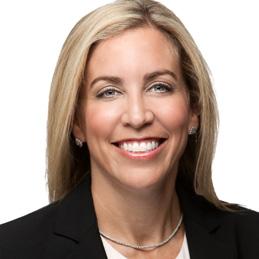
This month’s article focuses on the “why.” October’s article will focus on the “how” of engaging the next generation of leadership.
In an era of rapid change and evolving business landscapes, it is imperative for organizations to invest in preparing the next generation for leadership roles. Failing to do so not only jeopardizes the long-term success of businesses but poses a significant crisis. Without adequately developing and equipping the next leadership generation with the skills and knowledge necessary, companies risk stagnation, missed opportunities and a lack of innovation. This article explores the pressing need for businesses to prioritize preparing the next generation for leadership while outlining the potential consequences of neglecting this crucial aspect.
Bruce Weber is founder and president/CEO at Weber Group. Weber brings more than 20 years of experience to the for-profit and nonprofit community, working with startup, growth and mature organizations. His focus is in strengthening organizations through strategic planning, organizational development, leadership and board development. He is a BoardSource Certified Governance trainer and a founding partner of the Nonprofit Lifecycles Institute. webergroupaz.com

AUG.
Businesses must anticipate and plan for leadership succession to ensure continuity and avoid a crisis. By preparing the next generation of leaders, organizations create a pipeline of talent that can seamlessly transition into key roles. Neglecting to develop emerging leaders can lead to a leadership gap, leaving businesses vulnerable and lacking the necessary expertise to navigate challenges and capitalize on opportunities. Effective succession planning involves identifying high-potential individuals and providing them with growth opportunities, mentorship and training to foster their leadership abilities.

Preparing the next generation for leadership roles is crucial for fostering innovation and adaptability within organizations. As markets evolve and new technologies emerge, businesses must be agile and responsive. Young leaders bring fresh perspectives, technological fluency and a willingness to challenge the status quo. By nurturing their potential, businesses can harness their innovative thinking and embrace change, remaining competitive in a rapidly evolving landscape.
Companies that neglect to prepare the next generation for leadership risk losing their top talent to competitors.
“The greatest leader is not necessarily the one who does the greatest things. It is the one that gets people to do the greatest things.” —President Ronald Reagan
Today’s young professionals seek opportunities for growth, development and advancement. When organizations fail to provide a clear pathway for progression and invest in leadership development, they become less attractive to ambitious individuals. This approach not only helps retain top performers but also attracts high-potential candidates who value personal and professional growth opportunities.
The next generation of leaders will need to understand the changing needs and preferences of customers. As demographics shift and consumer expectations evolve, businesses must adapt their strategies and offerings accordingly. By involving young leaders in decision-making processes and preparing them for leadership, organizations will leverage their insights and market understanding. Neglecting to do so may result in a widening gap between businesses and their target audience.
Preparing the next generation for leadership is essential for fostering diversity and inclusion within organizations. Through actively cultivating a diverse leadership pipeline, businesses can benefit from varied perspectives, ideas and approaches. Young leaders from different backgrounds bring unique insights that can lead to more innovative problem-solving and decisionmaking.
The crisis facing businesses that fail to prepare the next generation for leadership roles is real and multifaceted. From leadership succession and innovation to talent retention and meeting customer demands, the consequences of neglecting this crucial aspect can be detrimental. By prioritizing the development and empowerment of young individuals, organizations can ensure their relevance and profitability for the long term!
The pandemic dramatically accelerated the rise of remote and hybrid work, resulting in many companies downsizing their office space. This trend is expected to continue due to investments in technology and shifts in worker expectations.
Companies that are demanding amenity-rich, highperformance workplaces are now migrating to new, Class A buildings, leaving Class B and C properties sitting vacant and at risk. But by thinking creatively, it’s possible to convert these buildings into engaging, health-and-wellness-driven, diverse typologies — from residential to hospitality to community spaces.
Following the national trend, our Gensler Phoenix office has started to be approached by developers who are interested in exploring these building conversions. Gensler has designed a scoring algorithm to quickly determine which buildings make good conversions, based on factors like site context, building form, floor plates, envelope and servicing. Through this algorithm, we can evaluate assets quickly and draw rapid conclusions about the initial suitability of transforming office buildings into various uses. The system has been developed to align with a developer’s pro-forma or business model for a project.
Phoenix has a significant stock of Class B and Class C office buildings that are well suited for conversion to first-class, market-rate residential buildings. These are often three- to fivestory garden-style office buildings or non-performing high-rise urban core structures as they are particularly good residential candidates because of several innate design elements.
One design feature is ceiling height. Office buildings typically have significantly higher ceilings, making the tall ceilings feel luxurious for residential. Similarly, offices are built with a plethora of windows, which easily transition to the needs of daylight and views in a residential setting.
In Phoenix, we really value the indoor-outdoor connection, and that becomes a significant driver for residential living decisions. Façade modifications have the potential to bring the outside in and create new common spaces for a residential building. Recessing the glazing line on the building can create private balconies for the units. Larger-scale modifications to the façade, coupled with removing parts of the floor plate, can carve out outdoor terraces for the building residents to enjoy the connection to the outdoors, recreation space and gardens.
One example of this type of conversion is Franklin Tower in Philadelphia. The vacant and outdated building was converted to a mixed-use residential tower. The first several floors include office tenants that create a street-level presence. The ninth floor features a continuous balcony that wraps the
building and presents an array of tenant-shared amenities, and the new two-story rooftop penthouse provides a fitness center, kitchen and lounge.
Another possible conversion of existing office building stock is to hospitality spaces. This takes advantage of the same residential conversion benefits, while also contributing to the pedestrian city experience.
The Westin Phoenix is an example of a hospitality conversion, with the first eight floors of an office building converted to a 278-key hotel. The geometric grid of the office plan easily converted to the standard hotel room width, and the atypical floor plates allowed for unique corner king and hospitality suites that connect directly to meeting rooms.
On the ground floor, there are two restaurants, a bar, valet and the addition of the pool on an urban block, making for an active pedestrian experience with visual and physical connectivity. These amenities increased the amount of engagement, compared to a limited flow of office workers at 8 a.m. and 5 p.m.
For some Class B and C office buildings, there’s yet another type of conversion opportunity, one from private, low-use spaces to ones that engage and connect to the community.

The Link, at 7th Street and Missouri, repositioned two existing stand-alone buildings into a vibrant Class A creative office campus. Originally, between the two buildings sat an underutilized courtyard. But now, in its place is a modern glass box atrium, full of natural daylight and a 40-foot biophilic wall. The three-story space includes a restaurant, bar, open seating areas and integrated art by local artists. Connecting the two buildings with this atrium has made the building available for tenants needing to lease larger spaces across the two buildings. But it has gone past being just an amenity of the workspace. It has become a true community asset by providing a social destination for the neighborhood and hosting various events.
By including this space conversion as a part of the building refresh, the space has become a recognizable icon that serves the greater community while simultaneously drawing in new office tenants.
To date, Gensler has assessed more than 15 million square feet of downtown office space in more than 300 buildings in 25 different cities across North America.

A nationally recognized architect and design leader, Jay Silverberg brings more than 30 years of experience to his role as Design Principal in the Gensler Phoenix office. He has collaborated on projects throughout Arizona and the Southwest. He applies his specialized expertise in large-scale, technically intricate projects, and is known for creating design solutions that embrace local context and are sympathetic to the survival of the unique Sonoran Desert environment. gensler.com

Philanthropic contributions by designation in 2022:
• Religion: $143.57 billion
• Human Services: $71.98 billion
• Education: $70.07 billion
• Foundations: $56.84 billion
• Health: $51.08 billion
• Public-Society Benefit: $46.86 billion
• International Affairs: $33.71 billion
• Arts, Culture, Humanities: $24.67 billion
• Environment/Animals: $16.10 billion
• Individuals: $12.98 billion
Remember: Rarely does a nonprofit fit into only one category; often, it offers programs and services in other areas as well. To expand fundraising dollars, organizations should explore institutional and individual donors who have a track record of supporting these top categories.
While economic uncertainty and stock market volatility have influenced giving patterns in the past, inflation’s impact created an anomaly in 2022 — a decline in giving, marking only the fourth drop in U.S. philanthropy over the last 40 years.
That said, Americans still gave a generous $499.33 billion to charity in 2022, despite the latest numbers from Giving USA 2023 indicating a 3.4% decline in overall giving and a decline in individual giving by 6.4%. The report measures the previous year’s philanthropic performance.
It’s not all doom and gloom, though. The GDP rose 9%, signaling that, despite such challenges, economic growth continues. Unemployment also is at its lowest in 50 years. The other good news: Corporate executives sitting on nonprofit boards can help their organizations adapt and strategize accordingly.
Understanding what, exactly, is at play is the first step. The decreased giving simply reflects today’s unique circumstances, including donors who are experiencing fatigue after having dug deeper into their pockets in response to COVID, social unrest and the political climate over the last few years. With the stock market dips at year end — the time when people commit gifts – many donors delayed giving decisions as opposed to postponing them.
What’s more, many donors clamored for normalcy as the pandemic waned — wanting to put COVID and all its health, social and economic outcomes behind — which meant less urgency for the funding of immediate needs and social justice causes. The exception was individual donors funneling dollars away from traditional giving to the Ukrainian war crisis.
But despite these challenges, many sectors are doing well. Giving increased for foundations (2.5%), bequests (2.3%) and corporations (2.3%). The top designations for charities — religion, human services, education, foundations and health — also increased this year. If history shows anything, it is that giving levels will rebound.
In the meantime, nonprofits should:
year versus multiple years; combination gifts (part cash, part planned or legacy gift); DAFs instead of outright cash; extended payment periods; unrestricted or in-relief-of-budget gifts instead of those supporting new initiatives or programs. Diversify the organization’s revenue and fundraising priorities. Show donors the organization is financially responsible and be transparent about the nonprofit’s financial position and fundraising achievements, prioritizing those initiatives with the greatest need and impact.
Think about short- and long-term funding. Identify — programmatically, operationally and financially — what resources the nonprofit needs short- and long-term. Communicate those needs to donors in a compelling way. Consider endowment fundraising. Donors want to know that the organizations they support are stable, sustainable and scalable — and that they’re prepared to weather future economic and societal storms. With this long-term stability in mind, endowments become more compelling.
Be patient and persistent. Build relationships for the long term, and steward donors in good times and bad. Don’t apologize for asking for money. Realize that, today, it may take more time, more negotiation and more creativity for donors to commit to a gift.

When in doubt, ask. They’re common questions: Will the donor be interested in capital or a program? How big should the ask be? Who makes the final giving decisions in the family? When’s a good time to ask? When in doubt, go to the source. Allow donors to be part of the process of developing the right ask. They want to make smart, impactful, rewarding investments. Working together can often garner the best results.
Richard Tollefson is founder and president of The Phoenix Philanthropy Group, an Arizona-based international consulting firm serving nonprofit organizations as well as institutional and individual philanthropists.
phoenixphilanthropy.com
AUG.
Go where the money is. Even though individual giving decreased during 2022, it still comprises the largest percentage of all giving and included $319 billion in philanthropy. Nonprofits shouldn’t forget that individuals also can give through their foundations, bequests and donoradvised funds (DAFs), all of which together represent 85% of giving. Pursue all sources in a balanced way.
Give donors options. Help donors explore what’s best for them: outright cash; multi-year pledges; planned and legacy gifts; unrestricted, temporarily and permanently restricted gifts; stocks, personal property, real property or trusts. Give donors flexible options for structuring their gifts: single fiscal
While inflation, disposable income and stock market declines have made donors a bit more skittish and concerned about their own finances and wealth, they continue to exhibit impressive resiliency. The most successful organizations adjust to these fears and act with innovation. They’re flexible with donors’ gift structures; they target donors with the most money — and most flexible money. They identify new donors and resources that reflect their nonprofits’ missions, and they engage community and volunteer leaders, giving them access to new projects and champions.
Giving USA: The Annual Report on Philanthropy is the seminal publication reporting on the sources and uses of charitable giving in the United States. Its research, conducted by the Indiana University Lilly Family School of Philanthropy, estimates all giving to all charitable organizations across the United States.


The GMC HUMMER EV SUV and Pickup are revolutionizing the rugged/luxury market with the 2024 editions. HUMMER EV’s unmistakable design is infused with signature cues. The front lighting animation greets driver and passengers alike with iconic H-illuminated taillamps reminding followers that HUMMER is making it in the EV market.
Drivers can go topless — stowing the available modular Sky Panels or other gear in the power eTrunk™ with up to 11.3 cubic feet of space. There’s a 12-volt power outlet, lighting and four cargo D-rings. The MultiPro™ Tailgate, standard on the HUMMER EV Pickup, helps improve accessing, loading and unloading the cargo bed, while the Power Swing Gate on the SUV opens and closes using the key fob or a rear exterior button for easy access on or off the trails. The Power Rear Drop Glass lowers to further enhance the open-air experience.
Utilizing steel plates and shields around the drive unit and battery pack, available full underbody armor, skid plates and rock sliders help protect HUMMER EVs in off-roading environments and are only included in the Extreme Off-Road Package. Super Cruise is a driver-assistance technology for handsfree driving. The technology allows drivers to use features such as Automatic Lane Change on up to 400,000 miles of compatible roads in the U.S. and Canada. All HUMMER EV vehicles include a three-year subscription to this service.
Available 4-Wheel Steer provides the maneuvering flexibility of CrabWalk — a revolutionary available setting. This allows the rear wheels to turn in the same direction as the front, up to 10 degrees in either direction, to drive diagonally at low speeds to help in traversing tight trails.
One-Pedal Driving in the GMC HUMMER EV SUV allows for great controlled acceleration and deceleration with just the accelerator. It captures energy using Regenerative Braking to slow the vehicle down and repurpose that energy to help extend driving range.

Charging at home is available with the recommended 240volt at-home chargers to provide a convenient way to charge the supertruck so it’s always ready to go. With an EPA estimate of up to 314 miles electric range on full charge, range anxiety will never be an issue.
—Mike HunterHummer gmc.com/electric/hummer-ev

Sendoso, the leader in direct marketing automation, offers a unique and innovative solution for businesses seeking to engage with their customers and prospects on a more personal level. Sendoso enables small and mid-size businesses with a gifting solution to easily make an impression, open doors and drive meaningful interactions. With the expansive and diverse Sendoso Marketplace of eGifts, virtual experiences, and high-quality items from globally recognized brands, finding the perfect corporate gift has never been easier.
Recent operations expansions, including a new facility in Phoenix, showcases Sendoso’s strong capabilities to meet the increased demand for its services, and this signifies Sendoso’s commitment to both efficiently fulfilling orders and catering to the growing needs of its clients. As the demand for personalized and memorable experiences continues to rise, Sendoso’s expanded capacity ensures timely and reliable delivery of a wide range of items.
The Sendoso platform offers an expansive array of services for companies to leverage, including lead generation, customer appreciation, employee recognition and virtual events. Whether it’s sending a welcome package to a new client, a thank-you gift to a loyal customer or a branded swag item to promote a product launch, Sendoso’s platform offers flexibility and scalability to suit diverse business needs.
Human connection is coveted more than ever in an increasingly digital world. Sendoso empowers businesses to stand out by bridging the gap between online and offline interactions, and the opportunities are endless to create meaningful, memorable moments for clients that foster stronger relationships with their audiences. —Kris Rudeegraap, CEO and co-founder of Sendoso (sendoso.com)
GMC 2024
HUMMER EV
EPA-est. Range: Up to 314 miles
Horsepower: Up to 830 hp
Torque: Up to 11,500 lb-ft
Regen on Demand† allows drivers to recapture energy and extend the supertrucks’ range simply by holding the steering wheel’s Regen on Demand paddle when deceleration is needed. The supertrucks use Regenerative Braking to convert the energy created from braking into electricity to recharge the battery energy and help maximize range.
DON’T
$17
 by Madeleine Bell
by Madeleine Bell
With two locations in the Phoenix metro area, Z’Tejas offers a captivating fusion of modernity, sophistication and a unique take on Tex-Mex cuisine.
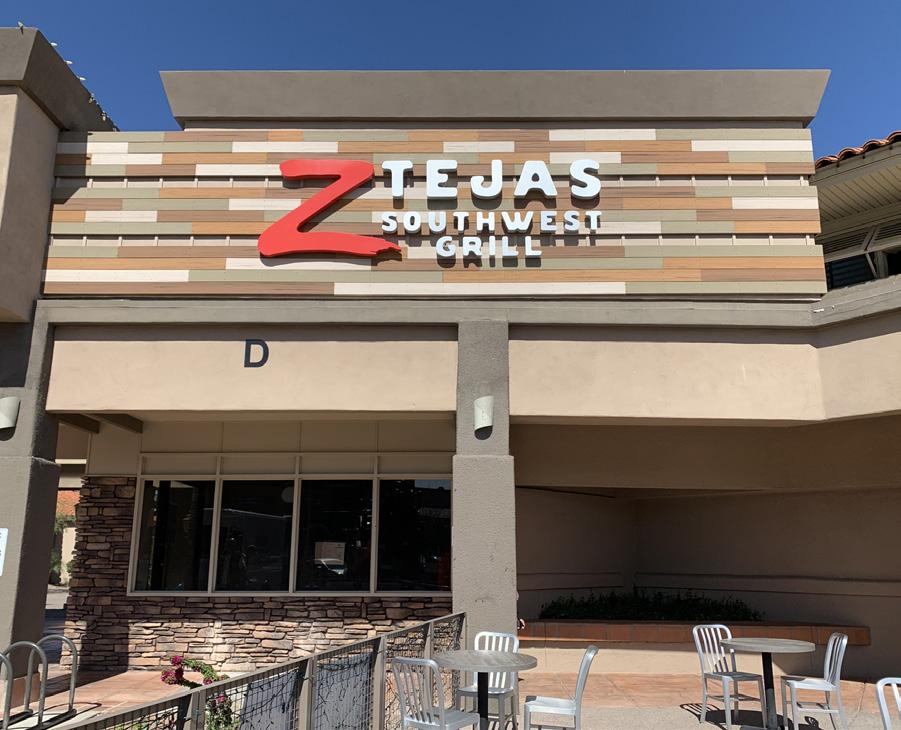
$25
Through extensive renovations in 2021, Z’Tejas elevated its interior to combine contemporary elegance with a Southwest ambience. From luxurious furnishings to thoughtfully curated lighting, every detail is meticulously orchestrated to create a refined yet welcoming environment. Each corner is aesthetically pleasing, making it not only a dining destination but also an Instagram-worthy locale.
It’s not just the atmosphere that invites diners in — the menu is testament to the magic that can happen by marrying classic Tex-Mex with sophisticated Southern cuisine. The restaurant also offers seasonal menus, showcasing a dedication to fresh flavors.
Diners will find a variety of menu items; alongside fiery fajitas to gourmet enchiladas, Z’Tejas also offers dishes like grilled ruby trout, adobo chorizo meatloaf and jerk chicken diablo pasta. The smaller plates feature dishes like catfish beignets, shrimp tostada bites and the popular Z’Queso.
The restaurant also offers seasonal menus — this summer’s menu highlights crab, street corn and pineapple — and brunch. Each dish is prepared in the scratch kitchen using the freshest ingredients.



These hearty meals are complemented by an array of innovative cocktails and cultivated wines, adding another layer to the dining experience. Z’Tejas is especially known for its margaritas; staff say that the restaurant may not have invented the margarita, but it perfected it. The meticulous craftsmanship behind every dish and drink resonates with Z’Tejas’ commitment to culinary excellence.
Recently, Z’Tejas made a strategic decision to close its doors on Mondays. This decision stems from an evaluation of customer feedback and a careful analysis of dining trends in the industry. Rather than seeing this as a reduction in service, it’s more fitting to see it as a commitment to delivering excellence in all aspects of its operation.
$15
By being closed one day a week, Z’Tejas is able to channel additional resources into fine-tuning its operations. This includes enhancing staff training, refining menu offerings and developing new culinary concepts. The aim is to optimize every facet of Z’Tejas’ operation, ensuring that each diner receives not just a meal but an opportunity to experience an intricate fusion of culture, design and exceptional cuisine that captivates the senses and creates lasting memories.
Z’Tejas has a Chandler and a Scottsdale location. Both feature full-wall murals that continue the story of the restaurant’s unique take on Tex-Mex cuisine; the mural at the Scottsdale restaurant shows a woman holding Z’Tejas’ famous house margarita. In Scottsdale, guests can dine indoors or on a large patio that overlooks Marguerite Lake. Both locations also offer a full bar with seating and rentable event space.
Z’Tejas
7221 W. Ray Rd., Chandler • (480) 893-7550
8300 N. Hayden Rd., Scottsdale • (602) 767-4790 ztejas.com

The Tempe Chamber of Commerce and Rio Salado College have partnered to create the Tempe Workforce Skills Accelerator, which will offer three microcredentials to Tempe businesses to upskill their workforce. Through a partnership with the Tempe Chamber Foundation and Amazon, there will also be 20 scholarships available to underwrite the costs for those employers that would experience nancial hardship from enrolling their employees.

The program’s microcredentials are accredited, transferable and stackable to higher-level degrees, giving students the opportunity to further their education and in-demand workforce skills. Microcredentials provide evidence students have demonstrated speci c skills and competencies endorsed by the issuing institution. The available programs are: Small Business Management, Data Analytics, and Quality Customer Service.
“We are honored to partner with the Tempe Chamber of Commerce to address critical workforce skills gaps; provide socio economic mobility
pathways for the community; and empower an innovative, educated and inspired workforce,” said Rio Salado President Kate Smith.
“We are proud to be locking arms with Rio Salado College and to be partnering on such a timely and impactful program,” said Colin Diaz, ACE, IOM, Tempe Chamber President and CEO. “Education is not just about acquiring knowledge, but also about building skills that empower individuals to shape their own future. It can truly become the catalyst for unlocking the full potential of employees, paving the way for businesses to grow and prosper, while allowing the employees to thrive in a rapidly evolving job market.”
Presented by:
“AMAZON and the AMAZON logo are trademarks of Amazon.com, Inc. or its af liates.”
Earlier this year, a total of 29 Black, Indigenous and people of color micromanufacturers received up to $25,000 in grant funds they can use to help them grow their businesses. Micro-manufacturing is the creation of products in small quantities, often using smaller manufacturing facilities. According to the U.S. Small Business Administration, about 11% of Arizona small businesses are minority owned.
Entrepreneurship is one way that people can create nancial prosperity for themselves and their families. Recognizing that gap, the City of Tempe set aside $300,000 and partnered with Rep. Greg Stanton to secure $500,000 in federal funding. This $800,000 fund is providing up to $25,000 stipends to BIPOCowned businesses that they can use for rent, supplies, tools, anything they need to succeed.
The funding was dispersed by six organizations: FABRIC Tempe, the Tempe Chamber of Commerce, Hustle PHX, Paci c Southwest Minority Supplier Development Council, Rail CDC and State of Black Arizona. Grant recipients received a Tempe Chamber of Commerce membership and assistance with Minority Business Enterprise (MBE) certi cation.
Wells Fargo recently awarded the Tempe Chamber Foundation a $125,000 grant to bene t minority women business owners and presented it at the Summit for Black Women Entrepreneurs. Joining the Chamber in receiving the grant check was Mayor Corey Woods, who spoke about the importance of empowering business owners and ensuring minority youth see themselves represented in public and business leadership.
Grant recipients will receive a year of complimentary membership to the Tempe Chamber of Commerce, giving business owners additional resources and opportunities to make meaningful connections and partnerships. Applications for the grant will open in August 2023 and business owners can learn more about the quali cations at www.tempechamber.org.


Celebrating its 22nd year, the Tempe Chamber of Commerce and ASU Alumni are proud to partner with the entire ASU Sun Devil Football organization to help celebrate the start of the 2023 season with the Sun Devil Football kickoff luncheon, presented by San Tan Ford! The event will be Friday, August 25th, and will be held at the San Tan Ford Club inside Sun Devil Stadium.
With views of the eld and “A” mountain, this venue will make you feel like you are part of the game! Highlights include emcee Tim Healey giving his insights into the upcoming year, an interview with starting players, and Coach Kenny Dillingham. Attendees will also hear from the leadership of the ASU Alumni Association and ASU Athletics.
This event is open to the public, with Tempe Chamber of Commerce members receiving discounted admission. Registration is now open at www.tempechamber.org.
Please contact David Key at the chamber for sponsorship packages.
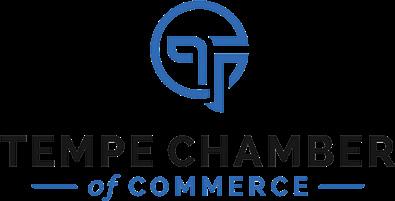
The Tempe Chamber of Commerce welcomes you to attend the 2023 Health, Wellness & Sustainability Summit, presented by SRP, on Friday, September 22nd at the SRP PERA Club. This event will include national and local experts who will offer business solutions and programs to help your organization save money and resources through sustainable practices.
Attendees will learn how to create a culture within their business that fosters sustainable practices, prioritize the health & wellness of their employees, and how going “green” may make you money and reduce expenses. The event includes a business expo and breakfast.
The Tempe Chamber is the only chamber in the United States with a Sustainability Pledge program dedicated to engage and educate businesses on sustainability practices. Learn how your organization can join a growing community of sustainable-minded businesses at www.tempesustainability.org
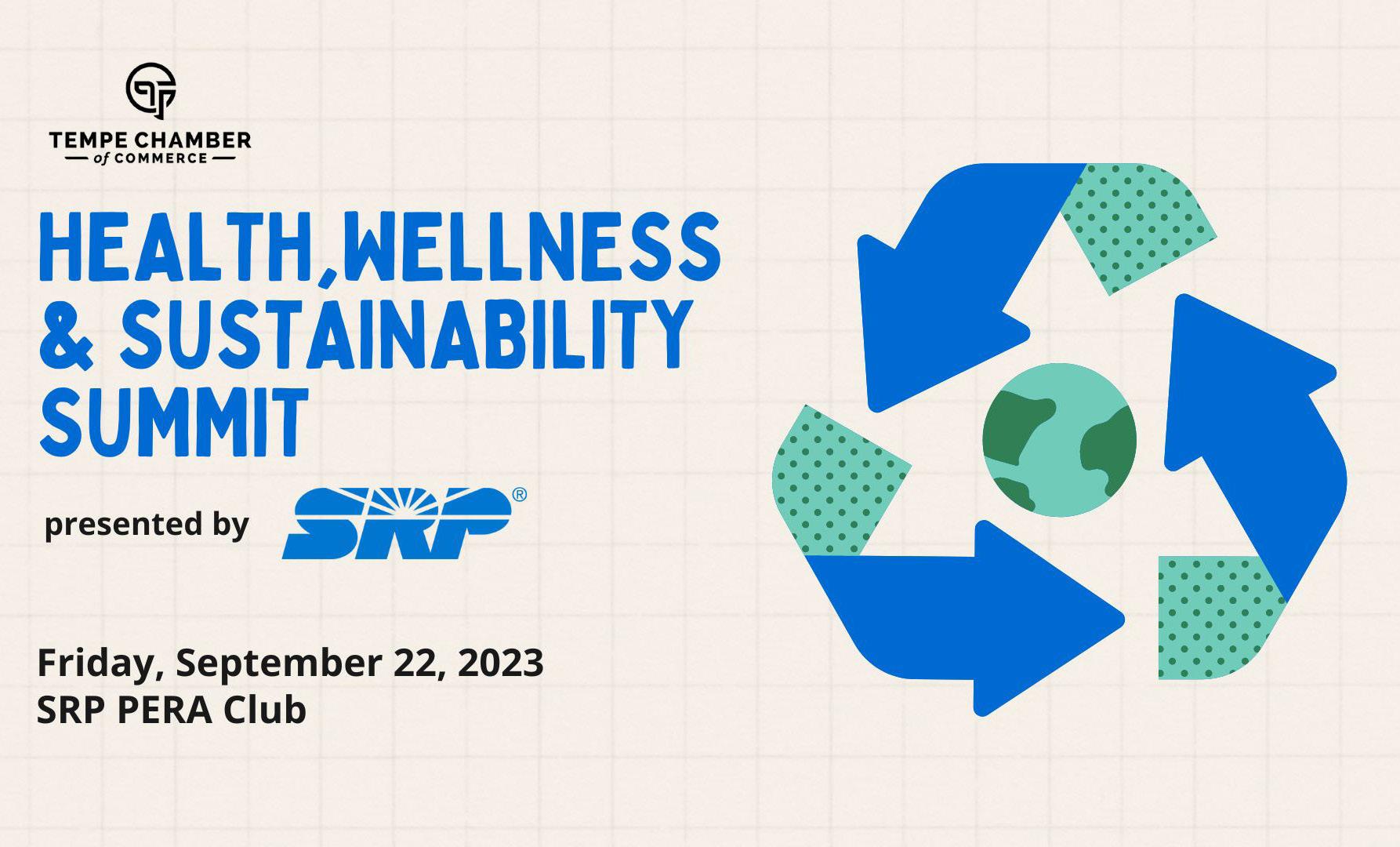
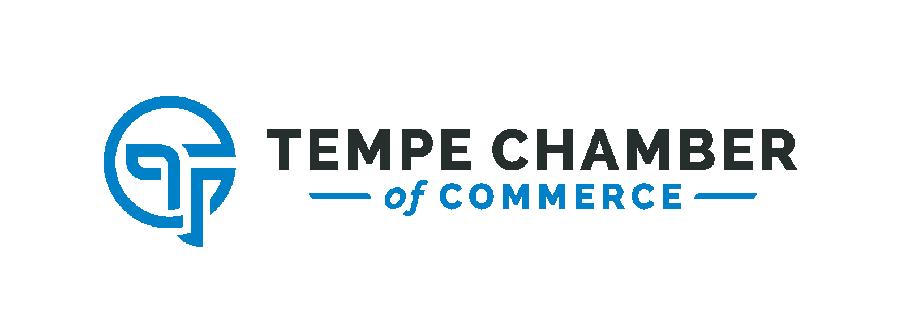


On Friday, May 19th, the Tempe Chamber of Commerce celebrated and recognized incredible businesses and leaders within our community at the 2023 Business Excellence Awards, presented by Southwest Airlines. Attendees at the Doubletree by Hilton Phoenix Tempe heard the State of the Chamber address from our President and CEO Colin Diaz, ACE, IOM, highlighting our successes and sharing a bold vision for the future. Highlights of the past year included partnering with the City
of Tempe and Congressman Greg Stanton on the BIPOC Micro-Manufacturing Grant, establishing the Tempe Workforce Skills Accelerator with Rio Salado College, and establishing new events such as the Economic Outlook and the upcoming 1st Annual Tempe Foundation Golf Classic.

The program included recognition of outgoing Board Chair Megan Martin, incoming Board Chair Suzy Greenwood, and the board of directors, committee chairs and staff who helped make it all happen.
Awardees included:
Spirit of Tempe
David Burckhard, Tempe Family YMCA
Volunteer of the Year
Melissa Nelson, United Food Bank
Outstanding Community Leadership
Rabbanni FurQaan, Tempe Leadership
Business Excellence Awards
Micro Business –




The Molecules Company
Small Business –
Brick Road Coffee
Large Business –

Penguin Air, Plumbing & Electrical
Nonprofit –Believe I Can Academy
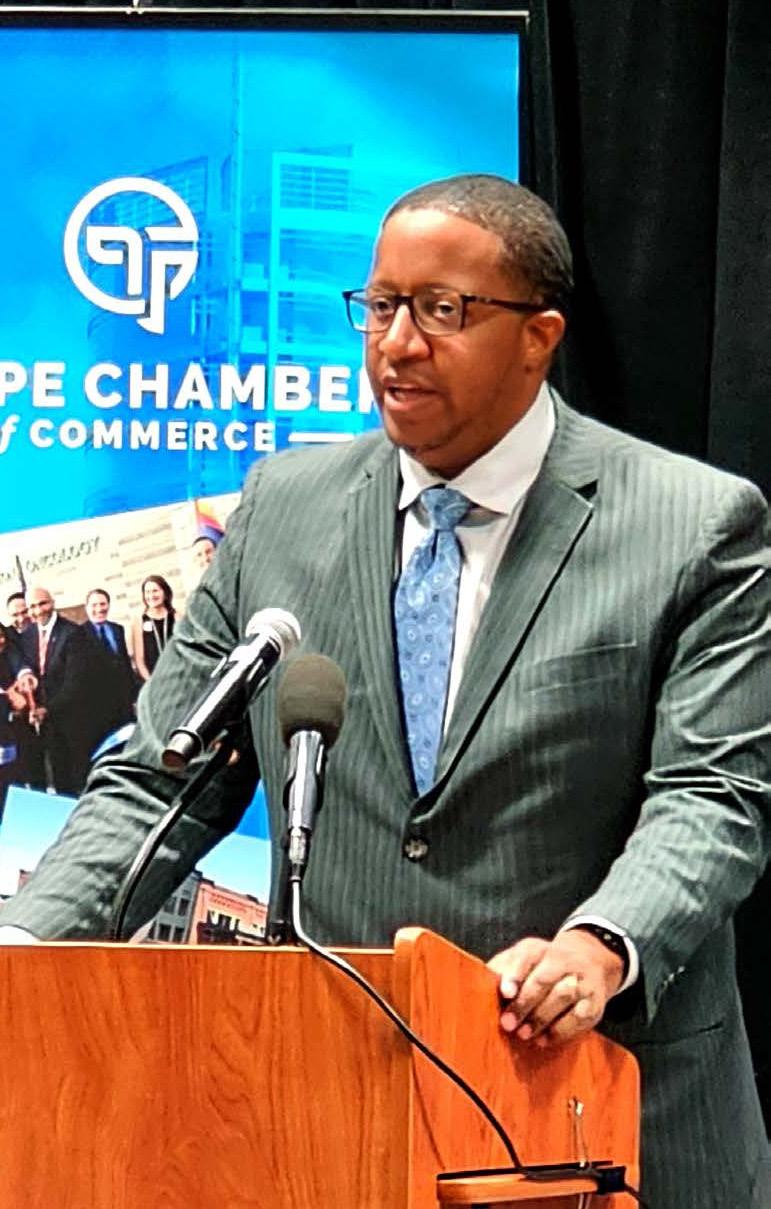

The Tempe Chamber Foundation carries out the charitable and educational objectives of the Tempe Chamber that positively impact Tempe’s quality of life. Tempe Leadership is a program of the Tempe Chamber Foundation, and more than 850 dedicated individuals have participated since its inception in 1985. Tempe Leadership also offers the Tempe Youth Leadership program and Tempe Cares.
In addition, the Career Ready Tempe youth workforce initiative in partnership with the City of Tempe aims to help prepare and develop Tempe youth to participate in the future workforce by connecting youth to college and career readiness support and partnering with Tempe employers to provide paid internship opportunities in elds that are in demand. Moving forward, the Tempe Chamber Foundation will also support the workforce development and D.E.I. initiatives of the Chamber and raise funding to address timely needs of our business and collective community. Among those focal areas are our recently established BIPOC (Black, Indigenous, People of Color) Micro-Manufacturing Grant, in partnership with the City of Tempe and Congressman Greg Stanton’s Of ce; our Minority Women in Business Supportive Grant, in partnership with Wells Fargo; and many others to come. Support of the Tempe Chamber Foundation is aligning with our commitment to ensure economic vitality, a strong workforce pipeline, and installing and sustaining the elements to keep Tempe a great place to live, play and do business. We are excited by the work that lies ahead and the huge impact that our foundation will play in it, and invite you to join us in these efforts.
Onward & Upward,
Colin Diaz, ACE, IOM President & CEO Tempe Chamber of Commerce & Tempe Chamber Foundation
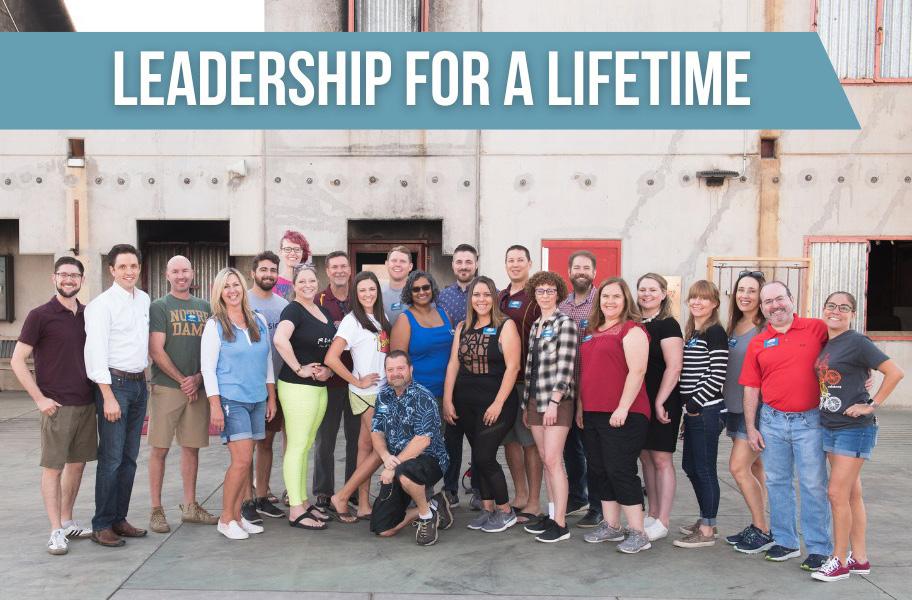
Tempe Leadership is a program of the Tempe Chamber of Commerce Foundation, and more than 700 diverse, dedicated individuals have participated in Tempe Leadership since its inception in 1985. Tempe Leadership brings together community-minded individuals in the community to engage and challenge one another, learn more about the ins and outs of Tempe and, most importantly, make a real difference in our community. Tempe Leadership also includes Tempe Youth Leadership and Tempe Cares.
Career Ready Tempe is a youth-workforce pilot program, funded by the U.S. Chamber of Commerce Foundation’s Career Readiness Lab Grant and the City of Tempe’s Innovation Fund. The program aims to prepare Tempe youth to participate in the future workforce and to develop the youth-talent pipeline in the City of Tempe so that it aligns with industry needs. This year, the program featured 29 interns who gained insight and education in a variety of industries, including fashion, nonpro t, nance, engineering and municipal roles.

The Women in Business Council will be hosting a Mentoring Program starting in December of 2023. The Mentoring Program was created in order to assist women and men in reaching and achieving their personal and professional goals and to create an environment in which they can prosper and celebrate their success. Being mentored is one of the most valuable and effective development opportunities you can offer employees.
For protégés, some key bene ts of business mentoring include:
Join other leaders in the community for the 2023–2024 Business Academy co-sponsored by Rio Salado College and presented by Wells Fargo. Gain valuable knowledge to help you grow your business! Exclusively for Tempe Chamber Members, the Tempe Chamber Business Academy is an opportunity for businesses and business leaders to gain the knowledge they need to grow their companies and strengthen our community.
Past attendees have learned from a combination of Rio Salado College instructors and business experts in the areas of sales, entrepreneurship, nance, HR, DE&I, employee engagement, cloud technologies and more. This year, a fall session will be hosted in October 2023 and a spring session will be hosted in April 2024.
• Exposure to new ideas and ways of thinking,
• Advice on developing strengths and overcoming weaknesses,
• Guidance on professional development and advancement,
• Increased visibility and recognition within the company and
• The opportunity to develop new skills and knowledge.
Applications to become a mentor or protégé will open in October, with pairings being announced in November.
In Fall 2023, the Tempe Chamber of Commerce will begin hosting a quarterly series of CEO Roundtables to address industry needs, nd solutions and create discussion about future policy. The program will feature C-suite executives, elected of cials and policymakers. Focus industries will include hospitality, food & beverage, manufacturing, retail, entertainment, education, nance and more. These discussions will also strengthen the relationship of business leaders with the Tempe Chamber to evaluate industry trends and future needs.






Board Chair: Suzy Greenwood
Incoming Chair: Tom Binge
Treasurer: Jayashree Ganesan
Immediate Past Chair: Megan Martin
Directors: Deborah Arteaga, Nick Bastian, John Bauer, CPA, MBA, Mike Bradley, Laura Briscoe, Beth Stull, Ashley Bunch, Jayashree Ganesan, Mark Holthaus, Matthew Heil, Mike Neely, Paul Quinn


Ex-Officios: Lori Foster, Kelsey Files, Rosa Inchausti, Tim Gomez, Michael Martin, Kate Smith
Committee Chairs: Tom Binge, Janńe Gutierrez, Jessica Brice, Ashley Bunch, Sukki Jahnke, Darrol Robinson, Alison Stine, Brian Stinson, Paul Quinn, Jonathan Yee
The Tempe Chamber of Commerce strengthens the local economy though networking, advocacy, professional development and in uence. It regularly advocates for a favorable business climate through interactive public policy engagement and provides ongoing representation in government at local, state and federal levels.
Tempe Chamber of Commerce



P.O. Box 28500
Tempe, AZ 85285 (480) 967-7891
www.tempechamber.org
FEATURING
Sandra Wilken Luxury Armstrong Properties
Bridge Real Estate & Relocation Concierge
Cambridge Properties
Joan Levinson Luxury Realty ONE Group

Silverleaf Realty
Steele & Davis Private Client Group
Russ Lyon Sotheby’s International Realty
Walt Danley Christie’s International Real Estate















Examining the latest market indicators closely, there are notable trends suggesting stability and positive prospects for the Greater Phoenix area, according to the latest data released by Phoenix REALTORS, the Valley’s preeminent real estate membership organization and most reputable source for real estate news today, with many resources that include a clearinghouse of up-to-date research, statistics and data offering insights on marketplace trends.
“Changes in interest rates, questions about the market and the dif culty of nding replacement homes are clouding the residential market,” says Butch Leiber, president of the Phoenix REALTORS’ board of directors and an active broker. “The major takeaway from the data is that the numbers don’t look as good as last year, but we’re holding steady in some of the key indicators like price and turnover, which is terri c news for the long term.”
Leiber explained that the “Unicorn Years” phenomenon of 2020–2022 is not re ective of the reality in the Valley. “The Unicorn years were unbridled boom years. But when we look at 2017–2019 — a period of relatively normal and expected growth — the market is tracking exactly where it should be,” he says.
“Sales prices are holding steady compared to April and May, with a median increase from $449,000 in May to $455,000 in June, but the real story is in seeing how our numbers fare historically,” Leiber says. “While the reality of year-over-year numbers may be stark when considering pending sales are down nearly 32% and new listings are down by 47.8%, the truth is that the Greater Phoenix area is doing quite well.”
Additionally, even looking at numbers from last year, there are growing signs of market stability:
• List price: The percentage of list price received for sales is the highest since March (98.6%, down just 1.9% from last year). In year-todate comparison, 98.1% is the highest since March, but that’s 3.3% less than last year’s 101.5%.
• Inventory/Days on Market: The 2.3-month supply of inventory is steady but trending downward. The lack of inventory can be attributed to sellers holding back listing their homes until interest rates improve, limited new construction and an influx of new residents to Arizona.
The market entered July with 13,072 homes in the inventory, which sits in the middle of the past four months, that ranged between a high of 13,676 in May and a low of 12,563 in April.
• New listings: While the June numbers — at 6,591 — were flat compared to May’s 6,953, they were higher than both March and April.
Some additional data revealed that pending sales dropped 12.1% from May but were down around 3% from March and April. At the same time, closed sales were down 9% from May and higher than in March or April.
“It’s hard to look ahead with the way the market data has been reporting, especially looking at year-over-year numbers,” Leiber says. “The statistics keep showing that, overall, the market is doing well since this winter. But comparing data to last year — an anomaly period — doesn’t give an accurate picture of how the market is performing this year.”
Leiber believes the numbers are showing that the Greater Phoenix area is in a healthy growth phase or a “new normal” after a period of untamed growth.
—Mike Hunter Phoenix REALTORS phoenixrealtors.comAs a part of our issue on housing, we have profiled the Top Residential Real Estate Leaders and Companies in the Valley. These leaders are among the most experienced and successful real estate brokerage firms and agents in all parts of the Valley. Each has been asked to provide information on their organizations and expertise. In Business Magazine officially recommends these residential real estate companies, individual leaders and their agents to our readership. We hope our readers will see the benefit of this information as they or their friends and colleagues are looking for residential real estate services in Greater Phoenix.
COMPANY NAME: Armstrong Properties

MAIN LOCAL OFFICE: 8340 E. Raintree Dr., Suite B-6 Scottsdale, AZ 85260
PHONE: (480) 390-6050
WEBSITE: sandrawilken.com
OFFICES IN METRO PHOENIX: 1
YEAR ESTABLISHED LOCALLY: 1976
TOP SPECIALIZED AREAS:
• Luxury Sales and Development
• Paradise Valley
• Gainey Ranch
• Scottsdale
• Concierge Services
PRINCIPAL AGENTS/ EXECUTIVES
Jon
Allison
Sandra Wilken’s love affair with the cities of Paradise Valley and Scottsdale began more than 50 years ago when her family relocated to Paradise Valley from Boston. Driven to be the best, Wilken quickly earned a reputation for providing her clients with high-quality professional services — all with a personal touch. During those early years, her portfolio of loyal clients continued to expand, catching the attention of several Canadian real estate developers. Their vision: Build premier developments in desirable locations throughout the Valley — but they needed an expert to ensure their success. Drawing on Wilken’s unique background in architecture, design, marketing and sales, a partnership was forged that ultimately led to the completion of several world-class developments, with the latest being The Phoenician and Gainey Ranch.

With Gainey Ranch complete, in 1995 Wilken launched Sandra Wilken Luxury Properties. Her vision for the new company was to go far beyond helping her clients buy and sell their homes. Her ambitious goal was to provide a list of expanded services for her clients who needed much more than the typical real estate transaction, thus planting the seeds for what has now become the novel concept of premier concierge services.

Being in the business for more than 47 years, Wilken is now unfortunately seeing the passing of many dear friends and clients. With that said, Wilken has expanded her “concierge company” to serve the very discerning needs of her clientele. The process has been streamlined for the family members left to not only sell the property but, rst, assist in the selling of any possessions and prepare the property to go on the market. A list is created for the seller of any construction/repair items necessary to complete prior to sale. The repairs are then performed in-house through the company and promptly as required. For buyers, assistance with remodeling recommendations is also completed in a timely manner. Wilken has a full list of all real estate-related services for her clients to use. Wilken’s goal is to offer truly rstclass service for any and all needs of the seller or buyer — essentially, offering a ONE STOP SHOP for all real estate needs.
Wilken continues to live her passion and commitment to helping clients nd their perfect home here in the Valley. She is truly honored and inspired to work with the best advisors and clientele in the most distinguished neighborhoods of Paradise Valley and Scottsdale.
Karen Armstrong, Broker Armstrong, Licensed Contractor Ikeler, Realtor, Transaction CoordinatorBridge Real Estate & Relocation Concierge is a long-standing Phoenix-based real estate company with residential sales and corporate relocation expertise. All Bridge clients receive the support of their personal Bridge Concierge Team, so they need to focus on decision making only, not the myriad of details associated with real estate transactions.
For executives considering selling homes or investment properties, their Bridge Concierge team manages all aspects of the project: from vendor management during property preparation to professional staging, culminating with widespread international marketing exposure. Since rst impressions are paramount and buyer decisions can occur in split seconds, Bridge offers clients the service and expertise to maximize their investment and sell within desired timelines.
For all buyers, including those relocating from other parts of the world, Bridge Real Estate Concierge has a Relocation Division specializing in helping ensure smooth housing transitions. Unlike most relocation companies, Bridge helps with all types of housing: renting or purchasing homes, luxury properties or investment properties.
With Metro Phoenix being so vast and diverse, Bridge Relocation Division helps clients focus rst on the community. This is different from other real estate rms. We rst look at what ts with lifestyle and hobbies, then schools, and only then …
COMPANY NAME: Bridge Real Estate & Relocation Concierge
MAIN LOCAL OFFICE: 2801 E. Camelback Rd., Suite 200 Phoenix, AZ 85015
PHONE: (602) 770-3311
WEBSITE: BridgeRelocation.com, BridgeREConcierge.com
NATIONALLY HEADQUARTERED: Phoenix
MANAGING PARTNER: Paige Heavey
NO. OF YEARS WITH FIRM: 18
YEAR ESTABLISHED LOCALLY:
housing. Using this approach, Bridge helps people avoid making costly mistakes.
In our 20+ years in Greater Phoenix, we’ve served more than 1,000 clients, from local Phoenicians to professionals from 26 different countries. To help smooth the move, our domestic and international concierges answer people’s transition questions before they arrive and long after they move here. Whether it be the right tennis club, dance studio or dentist, the Bridge domestic and international concierge helps create a smooth transition.
All Bridge Realtors come from corporate backgrounds and must earn their certi cation as a Bridge Local Area Housing Expert This certi cation builds deep negotiation skills, local market knowledge of unique community amenities available today and what’s coming soon. Fluent in six different languages, Bridge also has bilingual real estate professionals on staff who have strong cultural understanding of people from different parts of the world.
All Bridge clients experience white-glove treatment, including enjoying their favorite drinks and snacks while doing community tours and house hunting.
Attesting to its value delivered, Bridge enjoys long-term client relationships and double-digit revenue growth. Executives and Arizonans call on Bridge Real Estate Concierge whenever residential housing or relocation comes to mind.

Paige Heavey Fine Properties Group established 2005; Re-named Bridge Relocation Concierge, LLC in 2018
TOP SPECIALIZED AREAS:
• Concierge service offerings taking the workload off busy people so they only need to focus on decision making.
• All licensed realtors are Bridge certified, including negotiation and local market expertise.
• Domestic and international relocation concierges.
• Business owners, executives and physicians.
• Professionally certified in home staging.
Paige Heavey, Founder and President
Certified Bridge Housing Specialists:
Wendy Chovnick
Alli Dubberly
Rebecca Chen
Martin Lopez
Jim Casartelli
Christine Cothrun
Kristy Morgan
Lynne Edson
Susan Evans
Concierges:
Marsha Kennedy
COMPANY NAME: Cambridge Properties
MAIN LOCAL OFFICE:
14602 N. Tatum Blvd.
Phoenix, AZ 85032

PHONE: (602) 493-5100
WEBSITE: cambridgeproperties.com
NATIONALLY HEADQUARTERED: Phoenix
MANAGING PARTNER: Keith Mishkin
CEO & President, Designated Broker
NO. OF YEARS WITH FIRM: 29
YEAR ESTABLISHED LOCALLY: 1994
TOP SPECIALIZED AREAS:
• New Homes
• Urban Living
• Builder Services
• Commercial
Cambridge Properties has felt the growing pulse of luxury + urban living in the Metro Phoenix area for more than 20 years, and is recognized as one of the Valley’s premier residential brokers. With more than $2 billion in sales and more than 10,000 new-build and single-family homes sold at all price points, Cambridge Properties is at the forefront of this exceptional market for smart, vibrant, urban dwellers.
In addition to nding and selling our clients’ dream homes, Cambridge Properties has worked with developers across the Valley, providing them the edge needed to exceed their sales goals.
Founded in 1994, Cambridge Properties is recognized as one of the Valley’s premier brokers for luxury residential living. Most notably, since 2003 Cambridge Properties has closed more than $2 billion in new home sales of urban-lifestyle developments as well as single-family homes in Metro Phoenix. CEO Keith Mishkin directly oversees a highly experienced team of seasoned industry professionals and all aspects of the sales and marketing of a community from inception through completion.

With more than 10,000 homes sold in all price points, notable experience includes The Residences at 2211 Camelback, Esplanade

Place across from Biltmore Fashion Park, and Montelucia in Paradise Valley. In addition to the award-winning New Home Sales division, Cambridge Properties has a boutique resale and investment division with several of the top sales professionals in the market today.
By combining experience, knowledge and a true passion for the industry, our team of professionals has an unwavering commitment to exceeding expectations. Since 1994, our goal is to create lifetime relationships by helping clients de ne and achieve their own real estate objectives. Each relationship begins by listening with genuine care and understanding, then making suggestions and developing strategies based upon years of experience and a keen awareness of the current real estate market. We negotiate on our clients’ behalf with the highest level of professionalism, ability and con dence.
Everyone on the Cambridge Properties Team understands the only way to achieve our professional success is to help our clients realize theirs. We honor that level of trust by treating each client and their transaction the same as we would a valued family member. We look forward to working together.
Portico by Belgravia Group; an incredible luxury 112 condominium community coming soon
Consistently one of the Top 50 agents in the nation, Joan Levinson won awards as the Number 1 Real Estate Agent in Arizona in various media outlets in each year from 2017 to 2022. This includes ranking as #1 in 2022 in “The Thousand, as advertised in The Wall Street Journal”, #1 in the Phoenix Business Journal in each of 2020,2021 and 2022, and being named by Newsweek as one of “America’s Best Realtors, 2020”. She has ranked among the Top 250 Realtors in the Nation in each year since 2017, including ranking #40 in 2022. She is Arizona’s Premier Luxury Real Estate Expert.

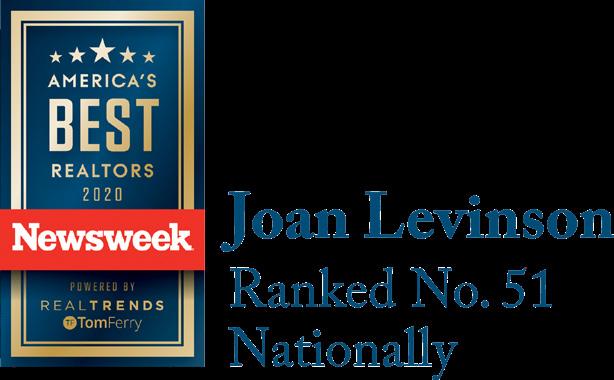
For over 35 years, Joan has specialized in the nest estates in Paradise Valley, Scottsdale, Phoenix, and Arcadia. Joan and her properties have appeared throughout TV and multiple major media outlets, including The Wall Street Journal, Forbes, Newsweek, Fox, ABC, NBC, Architectural Digest and more.
A record-breaking Realtor with a median sale price around $7 Million and over $2 billion in career sales, Joan is laser focused on the highest end of the luxury market and the most prestigious properties. According to all-time Arizona MLS records as of May 2023, she has represented twice as many clients in residential purchases
COMPANY NAME: Joan Levinson Luxury
Agent / Realty ONE Group
MAIN LOCAL OFFICE:
11211 N. Tatum Blvd.
Paradise Valley AZ 85028
PHONE: (480) 998-5673
WEBSITE: www.joanlevinson.com
MANAGING PARTNER: Joan Levinson
NO. OF YEARS WITH FIRM: 35
YEAR ESTABLISHED LOCALLY: 1988
TOP SPECIALIZED AREAS:
• Luxury
• Off-market Private Listings
• Concierge Service
and sales over $12 million than any other agent in state history. This includes multiple sales featured in The Wall Street Journal, the most expensive home sold in Paradise Valley history, and the then most expensive home sale in Arizona history.

Her real estate work is focused on discretion and white-glove concierge service. Many of her properties are sold off-market in private “pocket” listings. Her discerning clientele including multiple owners of professional sports teams, CEOs of Fortune 500 companies, professional athletes, and celebrities, who have come to rely on her honesty, creativity, enthusiasm, negotiating skills, and comprehensive knowledge of the luxury real estate market.
Over 80% of Joan’s business is from referrals of past clients.
Early in her career, Joan was named to the “International Who’s Who of Entrepreneurs” and also specialized in Commercial Real Estate, where she was multiply recognized as a “Top 5 Commercial Realtor in Scottsdale”.
Joan has lived in Paradise Valley for over 35 years and has acted as an advisor to the Town. She is currently serving a fourth term on the Board of Trustees of the Paradise Valley Mountain Preserve Trust.
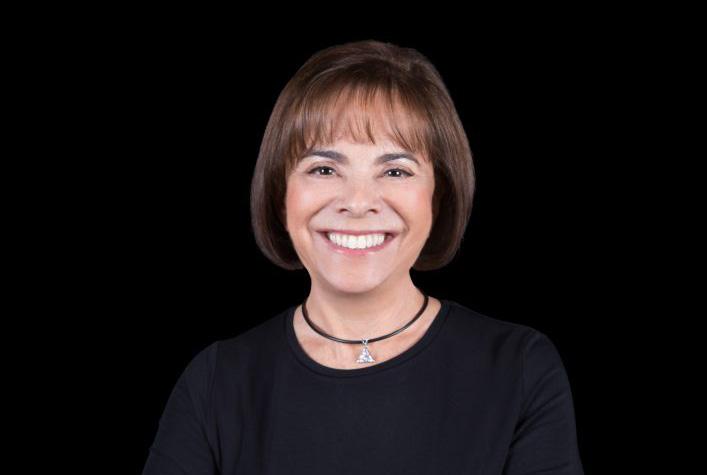
COMPANY NAME: Silverleaf Realty

MAIN LOCAL OFFICE:
18801 N. Thompson Peak Pkwy., Suite 100 Scottsdale, AZ 85255
PHONE: (480) 502-6902
WEBSITE: silverleafrealty.com
HEADQUARTERED: Scottsdale, AZ

MANAGING PARTNER: Mike Sweeney, Designated Broker/Sales Associate
NO. OF YEARS WITH FIRM: 23
YEAR ESTABLISHED LOCALLY: 2000
TOP SPECIALIZED AREAS:
• Luxury Real Estate
• Relocation Services
• International Buyers
• Concierge Services
• Athlete Representation

Silverleaf Realty’s exceptional expertise and focus on luxury properties is incomparable — no one understands the community, the lifestyle or the allure like we do. In addition to continually attracting new quali ed buyers, we have represented repeat buyers and sellers in multiple transactions. We understand our audience; we know what they want, where to nd them, and the best channels to reach them. Clients may work with one of our associates exclusively, but our entire team stands behind each individual. We devote 100% of our time providing the highest level of service to our clients. Since 2002, our exceptional expertise and depth of experience speaks for itself.
The Silverleaf Realty team is comprised of experienced, results‐driven individuals who are passionate about real estate. We know the luxury home market and understand the af uent community. Carefully selected, we bring passion, expertise and enthusiasm — all invaluable when delivering the outstanding performance that our clients deserve.
Silverleaf Realty has been an integral part of the Silverleaf community before the rst roads were even paved. The Silverleaf Realty team has
the most expertise on the past, present and future of this remarkable community.
Silverleaf Realty is a locally owned and operated real estate company dedicated to providing a luxury buying and selling experience throughout Arizona. A team of highly regarded Arizona-based agents assists customers with real-time knowledge and expertise from three locations: North Scottsdale, Old Town Scottsdale and Northern Arizona.
Silverleaf Realty specializes in real estate services throughout the Valley. Because of our team’s long-term involvement with homes and land for sale in these cities and communities, we are able to offer our clients – buyers, sellers and builders alike – a matchless level of knowledge, experience and expertise when it comes to the real estate services they need in Arizona’s marketplace.
Experts in luxury real estate, Silverleaf Realty agents specialize in providing guidance to buyers and sellers in the Valley’s most prestigious addresses. Located in the Silverleaf Sales and Information Center in Canyon Village in DC Ranch, our team offers in-depth knowledge about the many real estate opportunities and rich lifestyle available in the area.
COMPANY NAME: Steele & Davis
Private Client Group

MAIN LOCAL OFFICE: 6900 E. Camelback Rd., Suite 110
Scottsdale, AZ
PHONE: (602) 573-2288
WEBSITE: steeleanddavisrealtors.com
PRINCIPAL AGENTS/EXECUTIVES:
Patricia Davis, Market Expert
Camden Steele, Market Expert


Our team is part of the esteemed Private Client Group, where we offer unrivaled expertise in all facets of residential home ownership, both locally and globally. We share in the vision of PCG’s founder Frank Aazami, who has created a culture of excellence and luxury service in the real estate industry.
We strive to deliver proven results, driven by performance. Our methods are centered around clients’ individual needs, goals and timelines — solely focused on guiding and recommending winning strategies.
The Private Client Group has a motto of providing “the most powerful marketing program for Luxury Real Estate” and is proud to be part of the Sotheby’s International Realty network. Sotheby’s International Realty unites the nest and the most prestigious global properties for sale to the most sophisticated, knowledgeable and educated clientele from around the world. Our middle name is “International,” hence we are by far the most successful global real estate service provider in the world. If you are in search of that dynamic “local expert with global outreach” representation, and prefer to bene t from our venerable Sotheby’s brand, we welcome you to
schedule a discreet consultation with us today and learn more about the value and commitment we have to offer.
With more than $309 million in sales volume in just the year 2021 alone, the Private Client Group has been ranked No. 1 in Arizona for large teams by volume, No. 30 in the nation for large teams by volume, and ranks in the top .0165% of agents nationally! As leaders in Luxury Real Estate, we are also locally recognized, earning the title of 2023 Best Team from PHOENIX magazine and 2022 Most Productive Residential Phoenix Real Estate Teams from the Phoenix Bisiness Journal (to name just a few!).

But it’s not just about the business for us. For us, homes are more than just a business; they are a means of building stronger communities and helping others achieve their goals. We believe in the power of giving back to our community and clients. We embrace the philosophy of philanthropy, recognizing that with success comes a responsibility to help others. Our commitment to philanthropy and serving others is at the heart of everything we do. We strive to serve our clients with the utmost professionalism and care, and to make a positive impact on the lives of those around us.
NO. OF YEARS WITH FIRM: 29
YEAR ESTABLISHED LOCALLY: 1994
TOP SPECIALIZED AREAS:
• New Homes
• Urban Living
• Builder Services
• Commercial
COMPANY NAME: Russ Lyon Sotheby’s International Realty

MAIN LOCAL OFFICE:
6900 E. Camelback Rd., Suite 110 Scottsdale, AZ 85251
PHONE: (480) 287-5200
WEBSITE: russlyon.com
OFFICES IN METRO PHOENIX: 13
NATIONALLY HEADQUARTERED: Scottsdalre, AZ

MANAGING PARTNER: Jim Lyon, Chairman; Todd Gillenwater, CEO
NO. OF YEARS WITH FIRM: 19
YEAR ESTABLISHED LOCALLY: 1952
TOP SPECIALIZED AREAS:
• Luxury Real Estate

• Relocation Services
• International Buyers
• Concierge Services
• Rental Properties
• Property Management
PRINCIPAL AGENTS/ EXECUTIVES
Kevin Gonzales, Branch Manager, Pinnacle Peak
David Friedman, Branch Manager, Carefee & Desert Mountain
Cathy Green, Branch Manager, Southeast Valley
Sherri Monteith, Managing Broker, Camelback Tower
Will Rose, Branch Manager, Tucson
Tod Christensen, Branch Manager, Sedona
Gary Brasher, Branch Manager, Tubac
Bret Lamberson, Branch Manager, Flagstaff
Cindy Smith, Branch Manager, West Valley
Russ Lyon Sotheby’s International Realty has gathered realty craftsmen dedicated to the ideals of integrity and professionalism. From the ownership, management, agents and af liate services, every person involved in the company utilizes innovative skills, programs and technologies to create the nest real estate services company to be found.
The mission of Russ Lyon Sotheby’s International Realty is to provide its clients with the most responsive personalized service attainable — nothing less will do. The environment within Russ Lyon Sotheby’s International Realty is unique in the industry. Seasoned management innovatively supports the efforts of the company’s members to create a dynamic and inspiring
atmosphere that invigorates and hones the skills of everyone involved.
Collaboration and networking are fostered to create a synergy that puts the whole company to work for every client. The artistic blending of proven traditions and state-of-the-art innovation is unsurpassed. These assets are positioned on a base of nancial stability and corporate staying power.
Our agents bring the highest level of service and technology to today’s homebuyers and sellers, expanding our reputation as the most respected name in real estate. Our agents strive to deliver real estate experiences beyond expectations to enhance the lifestyles of our clients.
Walt Danley Christie’s International Real Estate is one of the nation’s most prestigious and successful luxury real estate rms, specializing in Arizona’s most af uent neighborhoods. Named one of the “35 Most In uential People in Luxury Real Estate,” founder and president Walt Danley started his real estate career in Paradise Valley more than 40 years ago and has consistently placed among the top 1% of real estate agents in the United States. He has assembled a growing team of top luxury real estate specialists and opened his namesake brokerage in 2011.


Our rm consistently lands a place on REAL Trend’s The Thousand list in the categories of top-producing agent and teams, including the No. 1 ranking in Arizona. We have earned a reputation as the premier luxury residential real estate brokerage in Arizona by combining profound market knowledge, expertise and the largest inventory of million-dollar estates within Arizona.
In collaboration with our partners at Christie’s Luxury De ned, we present international homes with special spaces to survey the stars. From a Gothic Irish castle with its own glassed-in viewing area to a Caribbean waterfront retreat with a private observatory, these spectacular residences are ideal vantages for gazing at the stars and observing celestial events.
Our team knows this market and we know the luxury brand. Arizona luxury homes are always in high demand, and those that offer spacious home of ces or libraries with impeccably designed wood elements tend to attract the most exclusive homebuyer. From wood-coffered ceilings to towering bookcases made of mahoganies and oaks, interior spaces featuring a high attention on wood often invoke a more relaxing and cozy atmosphere. These decorative features also blend perfectly with the surrounding Arizona landscape, where nature’s beauty is often easily viewable from the windows of the library or home of ce itself.
Nothing about selling one’s home is easy. The process proves nancially and emotionally complex for even the most seasoned seller. For a smooth transaction and stress-free transition, a seller must put the same thought and care in deciding with whom to list as they would a nancial advisor, attorney or CPA.
With an unparalleled track record of successfully delivering results to our clients, our agency’s comprehensive marketing methodology is customized for each property, ensuring that each home is put in front of the largest pool of quali ed buyers. We refer to this systematic approach to marketing as The Danley Method.
COMPANY NAME: Walt Danley Christie’s
International Real Estate
MAIN LOCAL OFFICE:
3545 E. Indian School Rd. Phoenix, AZ 85018
PHONE: (480) 450-1518
WEBSITE: waltdanley.com
HEADQUARTERED: 1
MANAGING PARTNER: Walt Danley
NO. OF YEARS WITH FIRM: 12
YEAR ESTABLISHED LOCALLY: 2011
TOP SPECIALIZED AREAS:
• Luxury Real Estate

• Relocation Services
• International Buyers
• Concierge Services

Armstrong, Jon, 56
Armstrong, Karen, 56
Bartlett, Steven, 35
Brasher, Gary, 62
Bury, Randy, 26
Carlson, John, 26
Casartelli, Jim, 57
Chen, Rebecca, 57
Chovnick, Wendy, 57
Christensen, Tod, 62
Cooper, Scott, 10
Cothrun, Christine, 57
Danley, Walt, 62
Davis, Patricia, 61
Demetriades, Christo, 16
Diaz, Colin, 50
Dillingham, Kenny, 48
Dubberly, Alli, 57
Eaton, Monica, 38
Edson, Lynne, 57
Evans, Susan, 57
Fann, Jacob, 24
Advantest Corporation, 18
Arizona Commerce Authority, 19
Arizona Office of Tourism, 54
Arizona State University, 18
Arizona Technology Council, 19
Armstrong Properties, 56
Bechtel, 18
Biotech Consulting of Arizona, LLC, 14
Bridge Real Estate & Relocation Concierge, 57
Cambridge Properties, 58
Camelot Homes, 26
Chargebacks911, 38
Cintas Corporation, 12
Conscious Capital Growth, 16
Courtesy Automotive Group, 66
Fanntastic Media, 24
Fennemore, 11
Foresight Technologies, 20
Gensler, 17, 43
Gilbert, Town of, 10
Goodmans, 68
Goodwill of Central and Northern Arizona, 64
Goodyear, City of, 10
Google Fiber, 24
Greenlight Communities, 26
Holualoa Companies, 67
HonorHealth, 23
Hummer, 45
Faussette, Sofia, 66 Friedman, David, 62
Gebran, Oscar, 40
Gillenwater, Todd, 62
Gonzales, Kevin, 62
Green, Cathy, 62
Hancock, Julie, 26
Hartke, Mayor Kevin, 18
Heavey, Paige, 57
Henderson, Dan, 10
Herrmann, Dora, 66
Hirsch, Paul, 18
Hoffman, Dennis, 26
Hull, Jeff, 20
Ikeler, Allison, 56
Jacques, Chris, 26
Kennedy, Marsha, 57
Lamber, Marc, 11
Lamberson, Bret, 62
Laughner, Maria, 26
Lawson-Garlutzo, Brandi, 22
Leiber, Butch, 26
Jive, 6
Joan Levinson Realty ONE Group, 59 Kiterocket, 21
Koibito Poké, 12
L. William Seidman Research Institute, 26
Littler, 41
Mark-Taylor Companies, 26
Moderne Communities, 26
MODUS Companies, 26
Northmarq, 26
Over Easy, 12
Paytient, 22
Peoria, City of, 26
Phoenix Philanthropy Group, The, 44
Phoenix REALTORS, 26, 55
Pita Jungle, 12
Plaza Companies, 67
Prisma, 5
Prologis, 13
ProTech Detailing, 13
Quasar Quantum Healing, 14
Revel Communities, 15
RFP Success Company, The, 12

Rio Salado College, 47
Russ Lyon Sotheby’s International Realty, 62
Scottsdale, City of Sendoso, 45
Silverleaf Realty, 60
Levinson, Joan, 59 Lopez, Martin, 57
Lyon, Jim, 62 Maddali, Raghu, 18
Martinez, Clarissa, 66
Mason, Christopher E., 35
Miller, Dana, 66
Mishkin, Keith, 58 Modus, Ed, 26
Monteith Sherri, 62 Morgan, Kristy, 57 Morris, Keenan, 35
Nadkarni, Shirish, 34 O’Neal, Tim, 26
Opaczewki, Danette, 15 Ozev, Sule, 18
Patel, Ishan, 24
Peckins, Misty, 66
Pizzillo, Mayor Joe, 10 Rehurek, Lisa, 12 Rose, Will, 62
Rudeegraap, Kris, 45
Spectrum Medical Care Center, 22
SRP, 7, 25
StandOut CV, 12
Stearns Bank, 6
Steele & Davis, Private Client Group, 61
Taylor Morrison, Inc., 9
Tempe Chamber Foundation, 47, 50
Tempe Chamber of Commerce, 47
Tempe, City of, 26, 47 Thrive Services Group, 26
Tiffany Bosco, 2 Tower Capital, 26 U.S. Chamber of Commerce, 51
Ryan, Catherine Hunt, 18
Samuels, Monica, 14
Schoenberg, Brad, 9
Shewale, Jaiprakash, 14
Shingles, Melissa L., 41
Silverberg, Jay, 43
Smith, Cindy, 62
Steele, Camden, 61
Stein, Jennifer, 26
Sweeney, Mike, 60
Tollefson, Richard, 44
Trautman, Austin, 15
Tulchinsky, Igor, 35
Watson, Sandra, 20
Watts, Pat, 26
Weber, Bruce, 42
Whorley, Brian, 22
Wilken, Sandra, 56
Woods, Mayor Corey, 20
U.S. Egg, 40
UnitedHealthcare, 3
Vali Homes, 15
W. P. Carey School of Business, 26
Walt Danley Christie’s International Real Estate, 62
Weber Group, 42
Wells Fargo, 47
Wexford Developments, 26
Wexford Real Estate Investors, 26
Willmeng Construction, 12
Z’Tejas, 46
The all-female Courtesy Automotive Group finance director “Dream Team” is comprised of Sofia Faussette, Dora Herrmann, Clarissa Martinez, Dana Miller and Misty Peckins, who bring their varied backgrounds and interests to their work at Courtesy Automotive Group’s diverse dealerships, as they describe in this article. Their individual tenures as finance director at Courtesy (not including previous experience elsewhere) are Faussette’s one year, Herrmann’s 29 years, Martinez’s seven years, Miller’s three years and Peckins’ six years. courtesyautomotive group.com

AUG.
Automotive dealerships are dominated by nearly 80% men, according to U.S. Bureau of Labor statistics from 2022, and yet the finance “Dream Team” at Phoenix-based Courtesy Automotive Group is a diverse team of five disparate females. We direct finance department operations across dealerships for a $1 billion dealership group. We believe our success has as much to do with being female as the expertise we bring to our work.
Our group is multidimensional and has an average tenure at Courtesy of 12 years. One of us has degrees in applied physics and mathematics, while others have a high school education. One is an herbalist and Tarot card reader while another is a former Texas beauty queen. Another of us races Ducatis and breeds Frenchies on the side. Still another owns and operates a community ice cream truck on the weekends. How we look at credit applications and build relationships with banks, our peers and our customers is driven by our female experience — and it’s a major part of Courtesy’s success.
Many dealership organizations with multiple brands have fierce competition between finance teams to see who can generate the most profit. We have gone in a different direction. The five of us share a strong bond that allows us to put aside ego and focus on the larger team success of Courtesy Automotive Group. We share resources and leverage each team member’s strengths to develop a workflow that benefits everyone, especially our employees.
Being wives and mothers has been crucial in our roles at work. In fact, we may be finance directors, but we are also “chief nurturers.” Many functions in the organization bubble up to finance, which means we are frequently in contact with employees across the enterprise who have roles outside of finance. These are often young people learning the business. We work to understand them and teach them the “Courtesy Way” so they can be their best professionally.
How we look at credit applications and build relationships with banks, our peers and our customers is driven by our female experience — and it’s a major part of Courtesy’s success.
Being both a professional and personal mentor to our younger team members has created opportunities for us to gain a holistic sense of our employees and helps us identify how to grow and promote them into different roles at Courtesy. This translates to success for our company as we help cultivate employees who are experienced, knowledgeable and want to make their career with us.
Given the challenges that exist for women in this industry, the fact that Courtesy’s executive team has given us their full support is remarkable and a testament to the Courtesy Way that permeates our office culture. It’s simple: We take care of our employees and they take care of our customers, resulting in a lifetime of loyalty from both.
We’ve all worked at other auto dealerships that have beat their chests about an amazing culture that ends up being mostly platitudes. Courtesy, however, has empowered us to define what the Courtesy Way means in our own roles. It’s an unspoken responsibility that we take very seriously.
A huge component of being a successful woman in this organization is not being judged for having a family. Just like the men, we are trusted to balance our personal and professional lives. Being moms and at the top of our professions also makes us role models for our children, and that makes us proud.
Courtesy Automotive Group started off as a familyowned Chevy store in 1955 and has grown to include Volvo, KIA, Chrysler, Dodge, Jeep, RAM and Isuzu Truck brands for individual and fleet purchasers in Arizona and California. Last year, we added Polestar to our collection with a dedicated EV store at Scottsdale’s Fashion Square Mall.
What we have seen firsthand is the power of female influence in a male-dominated industry. We’ve taken the hammer and broken through the glass ceiling, and our business is the better for it.


Companies have been proud to partner on some of the most transformational redevelopment projects in Arizona –including SkySong, the ASU Scottsdale Innovation Center and Park Central.

As two competitive, connected, and skilled real estate firms, our history of working with educational institutions and fostering publicprivate partnerships has taken each of our projects to the next level and we are excited to see the community impacts. For

